AUGUST WAS FULL OF VEGAN FASHION, A DISAPPEARING DIAMOND AND RADIOACTIVE VODKA!
FOOD
What Sandwich War? KFC Sells Out of Plant-Based ‘Chicken’ in Atlanta
Content Courtesy of: nytimes.com
Written by:
The fast-food chain tested Beyond Fried Chicken at one location this week.

For weeks, a debate over where to get the best chicken sandwich has waged between Popeyes, Chick-fil-A and the chicken-eating public at large. But KFC, another chicken giant with a global reach, is working on its own agenda: a plant-based “chicken” that proved so popular in a sales test that it sold out in a single day.
“It’s confusing, but it’s also delicious,” read a tweet from KFC on Monday announcing the sale of Beyond Fried Chicken, created with the help of the company Beyond Meat, at a single location in Atlanta. In about five hours on Tuesday, a KFC representative said, the restaurant sold as many plant-based boneless wings and nuggets as it would sell of its popular popcorn chicken in an entire week. (A “Kentucky Fried Miracle,” the company declared.)
The representative said the company started “talking with various plant-based suppliers this spring” and “decided to launch this very initial, limited test in Atlanta to gauge interest in plant-based options from KFC customers.”
Is a national rollout imminent? Not quite. The company now plans to evaluate the results of Tuesday’s test, and customer feedback, to determine what comes next, the representative said.
With the test, KFC joined several other major fast-food companies in dabbling in making meat alternatives more mainstream. Most are using either Beyond Meat’s products or those made by Impossible Foods to replace the meat in their most popular products — the Burger King Whopper, a White Castle slider and so on.
Is the idea to turn everyone into a vegetarian? Not exactly. But studies have shown that eating less meat could help both the environment and your health, and that could be making people a little more interested in cutting back.
“Our target customers for this product were flexitarians looking to incorporate plant-based choices into their diets,” the KFC representative said.
Here’s a look at what some of those companies are selling.
Burger King
In April, Burger King began testing its plant-based Impossible Whopper in St. Louis and later in other markets around the United States. This month, it took the sandwich nationwide.
The Impossible Whopper, made by Impossible Foods, is billed as “100% Whopper, 0% beef” and features a flame-grilled patty topped with tomatoes, onions, lettuce, mayonnaise, ketchup and pickles on a sesame seed bun. The sandwich is 630 calories and contains 34 grams of fat and 25 grams of protein, according to nutritional information on Burger King’s website. (A regular Whopper has 660 calories, 40 grams of fat and 28 grams of protein.)
[Read more about how the Impossible Whopper came to be.]
Dunkin’
The traditional breakfast sandwich got a makeover when Dunkin’ teamed up with Beyond Meat to serve the Beyond Sausage Breakfast Sandwich in July — but it’s currently available only in Manhattan.
The patty is served on an English muffin with egg and American cheese, and has 10 grams of plant-based protein.
[Read more about the unique foods being offered at fast-food chains, including Arby’s answers to plant-based meat.]

White Castle
White Castle began offering the Impossible Slider in April 2018 in 140 locations in New York, New Jersey and Chicago, the company said. By September, the plant-based slider, made by Impossible Foods, had been rolled out nationwide. On the one-year anniversary of its initial offering, White Castle announced that a newly formulated Impossible Slider was available in all its restaurants.
The slider comes with smoked Cheddar cheese and is 240 calories with 11 grams of protein. White Castle does not offer a vegan cheese for the slider, but said it was working to find an option.
Carl’s Jr.
The burger chain Carl’s Jr., based in Tennessee, introduced its own vegan patty at the beginning of the year. It worked with Beyond Meat to create the Beyond Famous Star, a plant-based version of the restaurant’s Famous Star burger, a release said.
The quarter-pound Beyond Burger patty comes with American cheese, lettuce, tomato, onions, dill pickles, special sauce and mayonnaise on a seeded bun. A nutritional breakdown on Carl Jr.’s website said that the sandwich is 710 calories with 40 grams of fat. It has a total of 30 grams of protein, with 20 grams coming from the patty.
Little Caesars
Outside the world of burgers and sandwiches, Little Caesars said in May that it was testing plant-based spicy-sweet sausage on its new Impossible Supreme pizza in Fort Myers, Fla.; Albuquerque; and Yakima, Wash. The sausage, by Impossible Foods, is made from plants, caramelized onions, mushrooms and green peppers. It has no cholesterol, 17 grams of protein and is 270 calories per quarter-pound serving.
The company said it began working with Impossible Foods to create a pizza topping earlier in 2019.
Qdoba
After a product test in Michigan, Qdoba announced in April that it was adding plant-based protein to 730 locations across the country. A news release for the restaurant said it would be the largest Mexican fast-casual chain to serve the protein from Impossible Foods.
The plant-based protein, which Qdoba said tastes and cooks like beef, is seasoned in the restaurant. Patrons can try it in a Qdoba Impossible Bowl or in a Qdoba Impossible Taco.
Not everyone is ready to go meatless
While some chains are embracing the plant-based trend, others are still thinking it through.
Arby’s, whose tag line is “We Have the Meats,” is heading in the opposite direction — last month it cheekily unveiled a carrot made from turkey, which it called the “marrot.” It’s unclear if the product will ever reach the menu.
And what about that fried chicken sandwich war that’s been dominating social media this month? Would we ever see Chick-fil-A and Popeyes duke it out over a vegetarian option?
At least one of those companies says it’s not likely any time soon. But Jackie Jags, a spokeswoman for Chick-fil-A, said its culinary team is always exploring new trends and menu offerings. “We are still in the early phases of evaluating if this is the right fit for our menu,” she said.
Content Courtesy of: cbsnews.com
Written by: CHRISTOPHER BRITO
Scientists distill vodka from Chernobyl's radioactive exclusion zone and say it seems safe to drink
Scientists have distilled vodka from ingredients found in the Chernobyl exclusion zone, creating the first consumer product out of the area since the nuclear disaster over 30 years ago. Called Atomik, the artisan vodka is actually an experiment from researchers looking into how much radioactivity would transfer over to crops grown in the zone, according to the Chernobyl Spirit Company, the team that created it.
Chernobyl Spirit Company made the liquor out of rye grain they planted in the exclusion zone and water from an aquifer in Chernobyl. After distilling it and conducting tests, James Smith, a University of Portsmouth environmental scientist and part of the group, told CBS News partner BBC they concluded that their product is "no more radioactive than any other vodka."
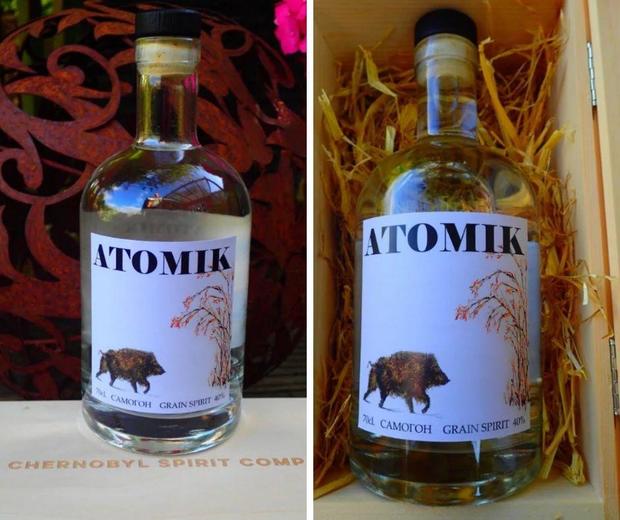
Atomik vodka was created as an experiment for scientists to analyze how much radioactivity transfers from crops grown in the Chernobyl exclusion zone.
"Any chemist will tell you, when you distill something, impurities stay in the waste product," Smith said. They sent the Chernobyl vodka to Southhampton University in the U.K. to undergo testing for possible radioactivity.
"They couldn't find anything — everything was below their limit of detection," he said.
The only problem with the vodka is that so far there's only one bottle of it, according to the BBC. The team said in a blog post they plan on making more bottles of Atomik, with the hope of making a profit to help local communities that surround the abandoned zone.
The recent HBO series "Chernobyl" renewed interest in the disaster and the site where it transpired. Fears of radiation have kept many away from the exclusion zone, which was evacuated in the aftermath of the 1986 nuclear accident, but thousands of tourists now travel to the site every year. So many, in fact, that Ukraine's president announced plans to make the site and surrounding areas more tourist friendly. The plans include new waterways and checkpoints in the area, enhanced cellphone reception and new walking trails. Filming restrictions will also be lifted.
Back in April 1986, when the region was part of the Soviet Union, a reactor at the Chernobyl nuclear power plant exploded, resulting in at least 32 deaths in the immediate aftermath. After initially downplaying the risk, the communist regime soon forced thousands of people to evacuate, turning the nearby city of Pripyat into a ghost town. Hundreds of square miles surrounding the reactor remain off limits.
ART
An Artist Will Make a $2 M. Diamond Disappear in Plain Sight at the New York Stock Exchange
Content Courtesy of: artnews.com
Written by:
Diamonds may be forever, but artist Diemut Strebe is planning to make a high-profile precious stone vanish.
Beginning on September 13, Strebe will have her work The Redemption of Vanity on display at the New York Stock Exchange. The piece is comprised of a 16.78 carat natural yellow diamond, valued at $2 million, which will be shrouded in “the blackest black ever created,” also known as carbon nanotubes. The effect of the carbon nanotubes, or CNT, will cause the diamond to become invisible to the naked eye. The piece will be on display until November 25.
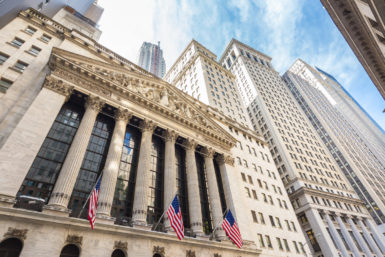
The New York Stock Exchange.
Strebe collaborated with a scientist at the Massachusetts Institute of Technology, where she is an artist-in-residence, to utilize the CNT. The scientist, Brian Wardle, who previously collaborated with Trevor Paglen on his 2012 project The Last Pictures, created the material, which absorbs 99.96 percent of surrounding light.
“That the piece is on display at the New York Stock Exchange is a good match. [The project] explores how material and immaterial value is attached to objects and concepts in reference to luxury, society and to art. ” Strebe told ARTnews. “Interestingly both the diamond and the carbon nanotubes are made of the same element, carbon, but their different atomic lattice structure is the reason for their opposite properties in exposure to light. The one reflects light to the extreme, and the other absorbs it to the most opposite extreme, drawing no shadows on the object. The CNT covered diamond will appear entirely flat.”
Strebe and Wardle are offering the development of CNT to be used by any artist, unlike Anish Kapoor’s exclusive ownership of his “vantablack,” which also absorbs nearly the same amount of light as Wardle’s creation. In a joint statement, Strebe and Wardle said, “We do not believe in exclusive ownership of any material or idea for any artwork and have opened our method to any artist.”
Diamonds have been the art world’s best friend as of late. In 2016, Jill Magid’s similarly science-adjacent project took the ashes of the late architect Luis Barragán and, with the help of a lab, alchemized them into a 2.02-carat diamond. Before that, Damien Hirst’s sculpture For The Love of God (2007) became one of his most recognizable pieces, as over 8,000 diamonds created a skull that cost £14 million ($17 million) to produce.
The diamond in Strebe’s piece comes from L.J. West Diamonds Inc., and Strebe explained that the price tag attached was highly important. “Value was key for this project,” she said. “[The diamond] is enormous! I’ve never seen anything like it. It’s a highly symbolic object. [This piece] could be seen as a challenge to the art market.”
Brother Sues Brother Over Warhol ‘Moonwalk’ Print
Written by: Tessa Solomon
It’s brother versus brother in a battle over proceeds from the sale of a Andy Warhol Moonwalk screenprint. On Wednesday, Keith Donaldson filed suit against his brother Robert in Hennepin County District Court in Minnesota over what the lawsuit alleges was an “unauthorized” sale of Keith’s Warhol.
According to civil court papers, the brothers had acquired the Warhol work—two prints published in an edition of 160—in 1999, and Robert held both pieces in his possession. In 2018, Keith asked for the return of what he believed was his half—only to learn Robert had sold both parts two years prior for $200,000, ultimately netting $180,000 after a commission.
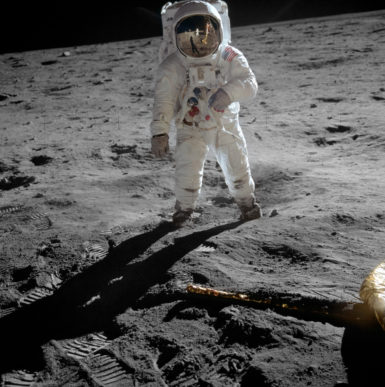
Aldrin atop the Moon during Apollo 11.
Moonwalk—merged stills featuring Buzz Aldrin and the American flag—was executed by Warhol in 1987, only months before his death. They were the only prints ever completed for TV, Warhol’s planned portfolio of monumental moments in American television history. At Sotheby’s in April, a set that was estimated at $250,000 to $350,000 sold for $312,500.
According to the lawsuit, Keith is requesting either the return of the print or at least $140,000, which he claims is the fair market value of one half of the work.
“Robert intentionally and improperly converted to his own use Keith’s art by selling it and intentionally and improperly converted to Robert’s own use of the proceeds of the sale of Keith’s art,” wrote Keith’s attorney, Julie Nagorski, in the lawsuit.
Attorneys representing Keith and Richard Donaldson did not immediately return requests for comment. A court date is not yet set.
Written by: Annie Armstrong
Christie’s to Sell Collection of ‘Kinky Boots’ Producer and Palm Beach ‘Grande Dame’ Terry Allen Kramer
Beginning this fall and continuing into 2020, Christie’s in New York will auction off more than 260 pieces of art and design from the collection of philanthropist and theater producer Terry Allen Kramer, who died in May at the age of 85. During her career, she produced Broadway hits such as Kinky Boots, Hello, Dolly!, and The Humans.
The lots, offered in an array of different sales, are estimated to bring in $20 million. On October 16, a sale dedicated to her collection will include works of art, decorative art, and furniture that filled her Upper East Side apartment and her estate in Palm Beach, Florida—whose society referred to her as its reigning “grande dame.”

Pablo Picasso, Buste d’homme (1968), which is estimated to sell for between $9 million and $12 million.
The biggest-ticket offerings will be included in Christie’s evening sale of Impressionist and modern art on November 11, where her late Picasso, Buste d’homme (1968), is estimated to go for between $9 million and $12 million. That auction also includes her Pissarro, Jardin et poulailler chez Octave Mirbeau, Les Damps (1892), estimated between $4 million to $6 million. Her collection also included works by artists such as as Aristide Maillol, Henri De Toulouse-Lautrec, and Mary Cassatt.
Christie’s will also be selling works on paper and prints from her collection by artists like Dalí, Léger, Matisse, Miró, and Picasso.
Max Carter, the head of Christie’s Impressionist and modern art department, said in a release that her collection “reflects the spirit of adventure and sense of fun she was legendary for, spanning the best of modern art from the late-19th to mid-20th centuries.”
FASHION
Fashion Is Dissent—How Style Played a Role in Equality Movements
Content Courtesy of: whowhatwear.com
Written by: JASMINE FOX-SULIAMAN

Women's Equality March and Strike, 1970
Some might say that style and politics are mutually exclusive. I’d beg to differ. Sure, the way you choose to dress can seem frivolous compared to the tragedies happening in the world, but the truth is that style has been and continues to be a tool for marginalized communities as a form of visual dissent. As we celebrate Women’s Equality Day and reflect on the history of how women fought for our right to participate in democracy (while wearing all-white, might I add), let us note the role style can play in the fight for the rights of all marginalized groups.
By no means am I looking to diminish the message of any movement, especially when we're advocating for human rights, but fashion doesn’t have to take away from the message or the fight; it can add to it. How you choose to dress can speak to your beliefs. Not only can your T-shirt say what you care about, but your purchases can impact the environment and the communities that are producing the products you buy. But you don’t have to take my word for it. Ahead, I’ve tapped fashion historian Laura McLaws Helms to speak to the intersection between style and politics and how style can be a form of dissent.

Tell us a little about yourself. Where did you study?
I grew up in New York City and London. I got my BFA in photography at Tisch School of the Arts, NYU, and then went on to get my masters from FIT in fashion and textile studies. Afterward, I did two years toward a Ph.D. in fashion history at LCF. Even as a little child, I was interested in fashion and especially historic fashion—poring over old photo albums, digging through trunks in my grandparents' attic, obsessing over paper dolls based on past eras. As soon as I could read, I was learning about fashion, and then I started collecting vintage from secondhand shops and car boot sales when I was a pre-teen, so it is unsurprising that I made fashion history my career.
As a fashion historian, how would you describe your job to those who don’t know what that is?
I study, research, and write about the interconnections between fashion and culture throughout history—looking to situate dress as an integral part of the culture, both shaping and shaped by how we live our lives. Most of my work currently is writing articles and consulting with brands about fashion history, but I’ve also curated museum exhibitions, written books, and given talks/seminars about fashion and cultural history.
You have a serious vintage collection. What era of clothing do you personally love and collect the most?
I really adore 1967 to 1973. It was an era of real fantasy in fashion. Historic revivalism met Bohemian luxe in a theatrical ode to times past and far-off places.

Suffragette picketing at the White House, 1917
Why do you think that in spaces of academia, and wider society, people are quick to dismiss the importance of fashion and its role in both historical movements and the cultural zeitgeist?
For centuries, society has seen fashion as frivolous and the purview of bored women with brains only for feathers and furbelows. While academic publications that have centered dress as a vital aspect of culture have begun to shift attitudes, it has been a very slow process over the last 60 years—though I’ve definitely seen an increase in acceptance and understanding of the value of fashion history and fashion itself in the last 10 years.

Proceeds go toward the ACLU.
From a historical lens, what examples would you give to shed light on the fact that marginalized communities use style as a visual indicator of their dissent against the political systems and societal “norms” that oppress them?
Often as a form of dissent, marginalized groups take aspects of their oppressor’s dress and subvert it. This can be very clearly seen by feminists over the years that have adopted masculine clothes—playing with androgyny, hinting at homosexuality, covered up in a suit or pants yet skirting the edges of what was considered “proper” and “appropriate” for a woman to wear. Lesbians like Romaine Brooks and her partners Natalie Barney and Lily de Gramont wore variations of masculine dress not in an attempt to pass as men but as a signal—a way of making their sexuality manifest. While gender fluidity and sexual freedom are accepted and understood (by most) today, in earlier decades, they were viewed with panic and as morally wrong.

Woman arrested for egging on the Zoot Suit Riots in 1943
Zoot suits were another form of subversive dress and bricolage. They were developed and popularized in African American and Mexican American communities in the 1940s, and for the wearers, the extravagantly flamboyant suits were a repudiation of the constrained and boring suits (and lives) of white society as well as a declaration of freedom and self-determination. The rebellion inherent in their exaggerated proportions led them to be associated in the media with delinquency, and many considered their voluminous use of fabric as wasteful and unpatriotic in light of textile rationing during World War II. The Zoot Suit Riots occurred in Los Angeles in 1943 when American servicemen and white civilians attacked and stripped primarily Mexican American youths clad in zoot suits; rooted in racism, white Americans viewed the zoot suits as an affront on traditional American values.


Pride March in London, 1988
Though we’re living in 2019, there are a lot of misconceptions about feminism, specifically how it impacts the clothing women who identify as such choose to wear. Why do you think society as a whole tends to think a feminist can’t dress in a "feminine" way?
Often, the media has depicted feminism as a total rejection of femininity and sexual orientation instead of a push for equality and a rejection of patriarchal dominance. While there have definitely been feminists who have rejected femininity and all its associated worlds (fashion, beauty, etc.), most have sought to remove the traditional strictures put on feminine life—the idea that women’s place was in the home, solely devoted to raising children and doing housework, all while looking fresh and beautiful for their husband. The happy homemaker, as she was so lovingly glorified at the time. Femininity and feminism do not have to be mutually exclusive, though they are often considered that way. And furthermore, identifying as a feminist doesn't determine your sexual orientation.

Dr. Martens has donated a portion of the sales of its Pride boots to The Trevor Project.

A young demonstrator protesting the Miss America beauty pageant, 1968
How has the way a typical “feminist” dresses evolved, and why do you think it’s so hard for society to believe that a woman can be both a feminist and still love fashion?
I don’t believe that there is a typical feminist or typical feminist dress. One of the greatest shifts to happen during the tumultuous changes of the 1960s was the breaking down of the idea that there is a single acceptable way for a woman to dress. Once any style is available and acceptable (jeans, suits, flowing dresses, etc.), the need to use dress to broadcast one’s beliefs and political alignments becomes less necessary (though still a totally valid mode of expression). A feminist can wear whatever she pleases today. I think in general, society is becoming more understanding that feminism does not equate to anti-feminine.


Feminist demonstration in New York, 1970
In terms of trends, which era indicated the greatest shift in women’s role within society?
The greatest shift in a woman’s role in society probably occurred in the 1960s. While the whole 20th century was full of advances in women’s rights and shifts in status, the 1960s was a decade of dramatic changes in women’s lives and also in their dress. At the turn of the decade, women were still expected to wear gloves, stay home, be docile, not enjoy sex. The pill was approved by the FDA in 1960, dramatically changing women’s sex lives and allowing women the opportunity to postpone children while pursuing careers. The Civil Rights Act of 1964 outlawed discrimination based on race, color, religion, sex, or national origin at the same time that miniskirts began to unveil women’s legs, for the first time not on a beach. All of the advancements in the women’s liberation movement and civil rights were so deeply connected with the opening up of women’s dress. In 10 years, women went from girdles, stockings, and gloves to no bras, pantyhose (first introduced in 1959 with the first seamless ones appearing in 1965), miniskirts, and jeans for everyday wear.


Women's March in Berlin, 2017
How do you feel culture uses style now as a political statement?
For the last few years, we have seen many fashion designers sending down their catwalks pieces that state in bold text grand political statements. Drawing clearly on Katharine Hamnett's iconic mid-1980s political slogan T-shirts, designers like Pyer Moss and Maria Grazia Chiuri at Dior have used their platforms to make clear political messages. These kinds of political slogan tees can be worn to boldly show any political allegiance, and a quick search online shows how omnipresent they are. Many elements of style that started as a sign of resistance and as a clear political signifier—like the LGBTQ+ rainbow—have now been commercialized by big business. They still have the same meaning but by becoming such a mass symbol have lost some of their anger and power.

One hundred percent of proceeds benefit NARAL Prochoice America.

Justice for All march in Washington, D.C., 2014
In conclusion, style has had a place not only in our closets but also in our cultural movements. It has been an integral part of every movement, from civil rights to LGBQT+ rights, and continues to be. There’s power in choosing to let your personal style break societal gender norms or choosing to buy sustainable, ethically made pieces. But ultimately, the biggest power is speaking up; you can wear your feminist T-shirt, but if you’re not showing up the marches or the polls, if you’re not educating yourself on the plights of other marginalized communities, or you’re not having difficult conversations with family members, then you’re just wearing a T-shirt. Style is only truly radical when put in action.

Vegan fashion: the latest, the greatest and what else to know
Content Courtesy of: fashionunited.uk
Written by: Simone Preuss
Vegan fashion - once snickered at as a short-lived fad at best - is now becoming fashionable, if not mainstream and even luxury brands are catching on and increasingly make do without fur, angora, mohair, exotic skins and even leather, wool and silk. Mainstream labels are setting examples, for instance Amsterdam-based denim brand Kings of Indigo is now a 100 percent vegan brand; luxury fashion brand Stella McCartney has always been vegan and pioneers like Loomstate, Planet Guests, Doshi and others are pushing boundaries when it comes to new standards in fashion. FashionUnited has taken a look at recent alternatives embraced by brands going fully or partly vegan.
Vegan brands
Vegan products are defined by PETA as being “clothes, shoes and accessories that contain no leather, fur, wool, skin, exotic skins or any other animal-derived fabric.” “Veganism as a lifestyle choice is more popular than ever and with ever-rising cruelty-free product demand, retailers, beauty brands and designers are raising their game to meet the animal-free market needs,“ finds the animal rights organisation.
Vegan handbag brand Gunas to launch beauty line
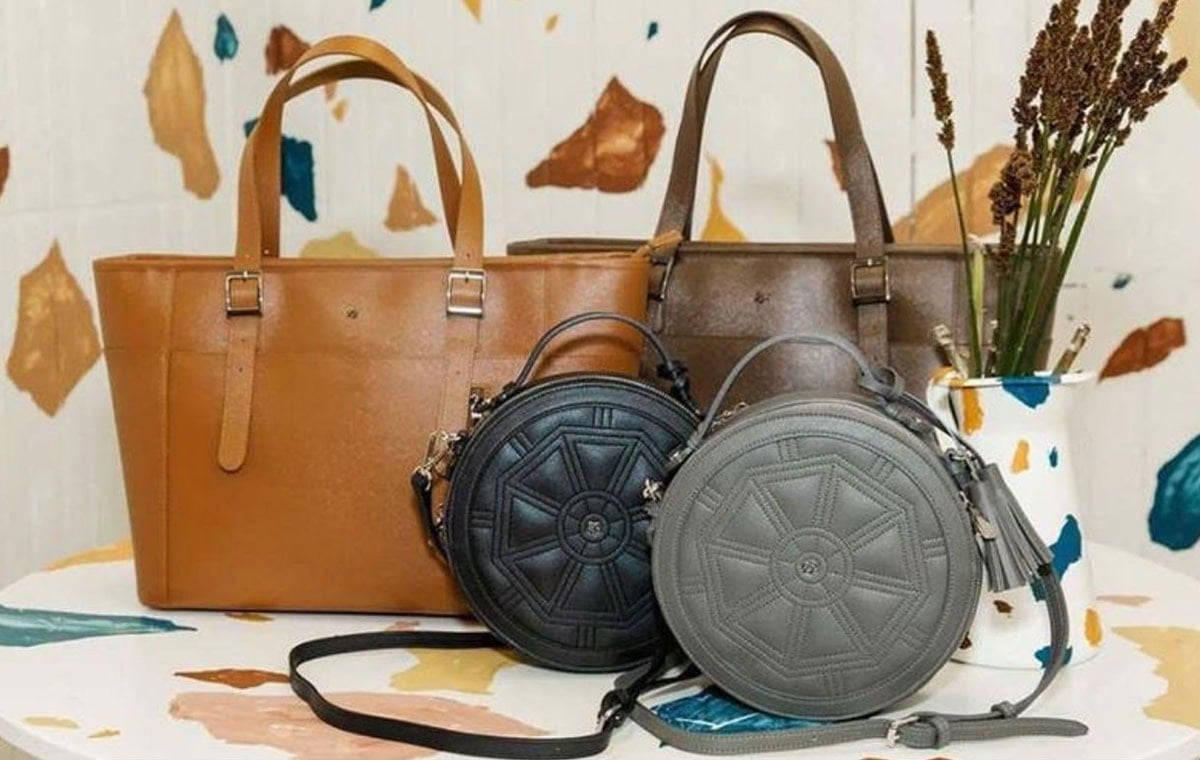
American vegan handbag company Gunas is known for creating cruelty-free handbags which are hand-crafted in South Korea, in sweatshop-free facilities. The brand announced the launching of a beauty line to produce 100 percent plant-based animal-free artisanal beauty bars, starting with pure olive oil soap in floral fragrances and volcanic ash.
Aldo and Call it Spring to eliminate single use shopping bags
The Canadian retailer of men’s and women’s shoes, Call It Spring, has become fully vegan by removing all animal materials from its entire product range. In keeping with its commitment to a greener future, Canadian Aldo Group, the first fashion footwear and accessories company in the world to be certified climate neutral, along with Call It Spring announced the bag-free initiative to phase out all single-use shopping bags from corporate stores globally.
Brands with vegan selections
Currently, countries like the US, UK, Germany and France are investing the most in the vegan market. According to London-based retail technology company Edited, by the end of January 2019, there was a 75 percent increase in products described as ‘vegan’ in the UK, 11 percent in the US, 12 percent in France, and a staggering 320 percent in Denmark. No wonder then that the beauty and footwear and also the fashion industry are increasingly putting their efforts into vegan products.
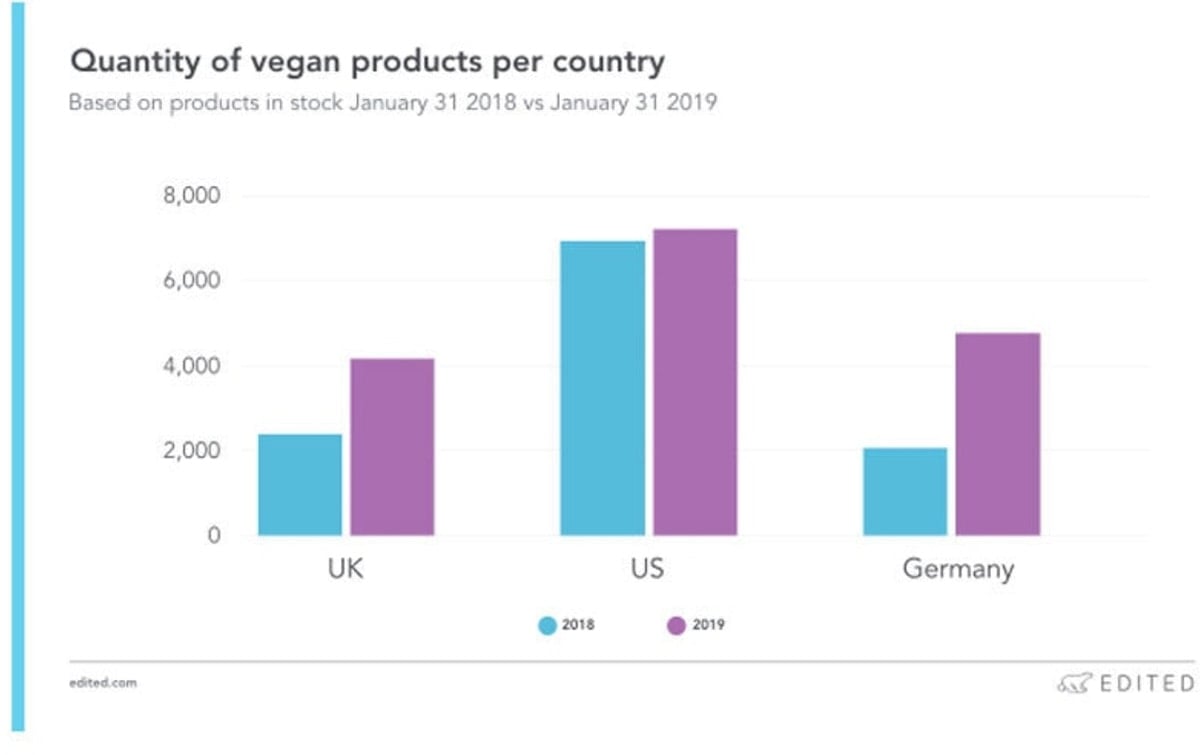
New Look launches range of vegan shoes and bags
British fashion giant New Look becomes the first high-street fashion retailer to register products with The Vegan Society’s Vegan Trademark. New Look’s registered products are free of animal-derived components, including any that might be found in fabrics, threads, glues, dyes and treatments, also the manufacturing process for the products and their materials are free of animal testing.
In pictures: Topshop launches its first vegan shoe collection
As the popularity of cruelty-free fashion continues to skyrocket, Topshop has joined the trend and launched its inaugural vegan shoe collection. Handmade in Spain, the PETA-approved vegan footwear collection comprises of six styles and features a neutral palette of snakes, croc, nude, toffee, orange, black and white across 12 options. In addition to the vegan footwear, items will be packaged in boxes assembled using 100 percent non-animal and non-fish glue.
Po-Zu announces first 100 percent vegan footwear collection
London-based ethical footwear brand, Po-Zu, announced its first 100 percent vegan AW19 mainline collection. The new range, includes sneakers, cork runners, flats and traditional walking and winter boots with a modern twist, it is made from ‘Apple Skin’ - vegan leather derived from the apple juice industry and grown in the Italian Alps - coconut husks, cork, rubberised cotton and pineapple leaves.

Global barefoot shoe brand Vivobarefoot has launched its most innovative sustainable shoe to date with its plant-based Primus Lite II Bio, the new vegan shoe is designed with more than 30 percent renewable plant-based materials, including Bio TPU made from yellow dent field corn and uses natural rubber and harvested algae called ‘Bloom’ instead of single-use petroleum materials.
Awards
M&S receives first-ever award from PETA for vegan retail
British multinational retailer Marks and Spencer has been recognized for its vegan efforts. PETA awarded M&S with its first ever “Vegan-Friendly High Street Retailer” recognition. The retailer's Plant Kitchen range offers over 50 vegan food dishes and M&S also introduced an affordable line of vegan footwear with 350 different styles.
What the experts have to say
Starting a new vegan label, product line or even just one product is not easy and those thinking about it should research the market, their target audience and the USP of their product or range well. FashionUnited has spoken with entrepreneurs from six innovative vegan brands that have learned a lot on their journey and are happy to share their experiences.
Brave GentleMan founder Joshua Katcher on building a vegan menswear brand
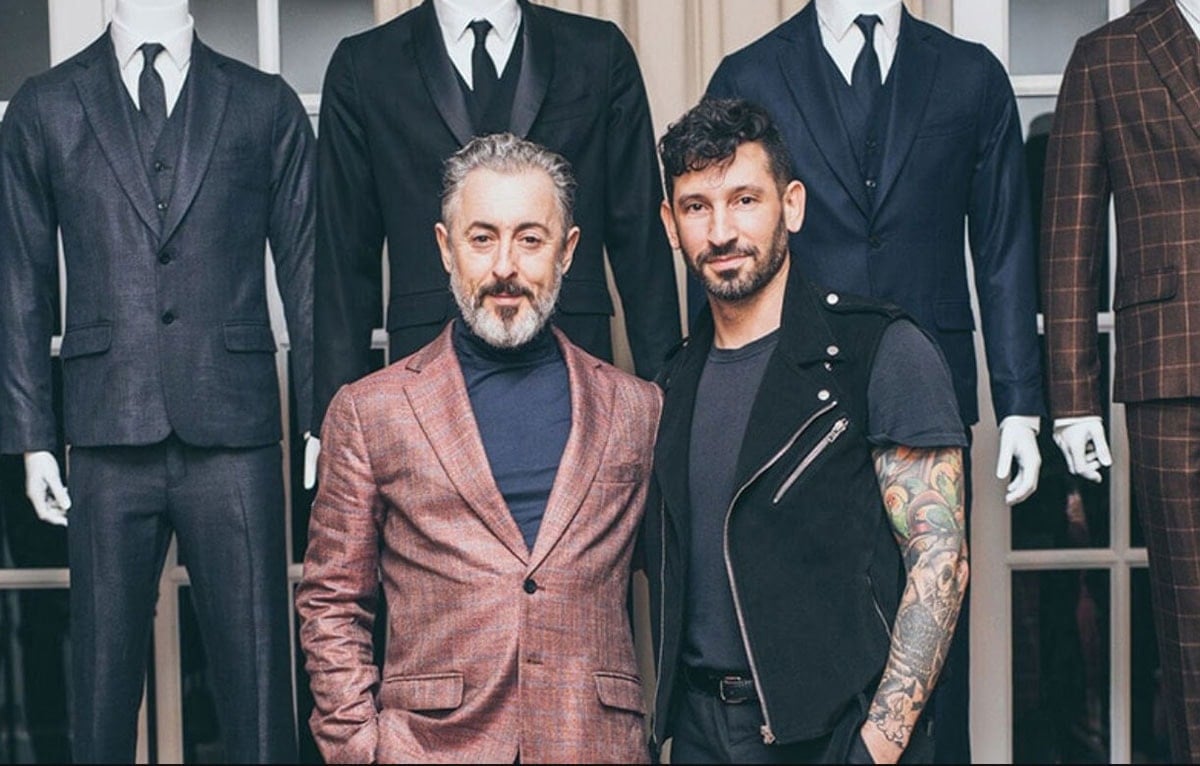
New York based high-end menswear clothing store Brave GentleMan offers a broad range of completely vegan menswear products, from 100 percent Italian-milled bamboo suits with buttons made from tagua nuts, to footwear made from EU Ecolabel-certified Italian PU. Future-wool, future-silk, future-ivory and future-slik are also used throughout the brand’s designs.
Vegan fashion: Q&A with British brand Beyond Skin
Brighton-based British footwear brand Beyond Skin has been creating stylish shoes that are ethical and vegan. Beyond Skin is on a mission to make cruelty-free fashion the way of the future. The brand has grown in popularity - both within the vegan community and outside of it - and has been worn by the likes of actress Natalie Portman at the Golden Globes, the Oscars, and in her movie “V for Vendetta”.
Vegan fashion: Q&A with mother-daughter brand HFS Collective

Los Angeles-based brand HFS Collective is an ethical and sustainable-driven brand that produces a selection of wallets and bags using solely vegan methods. Five percent of the brand’s earnings is donated to organisations that help empower women, protect animals and preserve the environment.
The rise of vegan fashion: Q&A with Delicious California
Headquartered in Folkestone’s Old High Street, UK, Delicious California is a 100 percent vegan independent brand which proudly describes itself as ‘ethical, original and fun’. Delicious California focuses on the environmental impact of the manufacturing process and uses water-based inks, and the cleaning products used in the screen printing process are environmentally friendly.
Vegan fashion: Brazilian brand Insecta Shoes wants to take over EU and North America

Brazillian brand Insecta Shoes, affectionately nicknamed “beetles,” are a rising vegan footwear label. The fabrics used are always upcycled, the sole is made from recycled rubber, the insole is made with surplus fabric from their own production and the sewing thread is made of recycled PET bottles. Insecta has a reversed logistics solution: When customers no longer want to wear the shoes, they can return them to the store to be recycled, avoiding generating more waste in the world.
Interview: Veja on its new biodegradable sneakers made from corn waste
French sneaker brand Veja has taken the industry by storm, with a simple but very smart concept: minimalist sneakers that make the world a little better through their ethical and sustainable design. In addition to organic cotton, recycled plastic and rubber from traditional sources, a new material is now being used: a leather substitute made from corn starch waste, a non-edible part of the plant.
Though the vegan lifestyle may not have (yet) become the new mainstream, it is certainly here to stay and brands and retailers are well advised to heed this trend. They should also do their research well as not everything sold as vegan is also environmentally friendly, thus not benefitting people or animals in the long run. What is sold as “vegan leather”, for example, is often nothing but polyester or polyurethane. But as we have seen, there are many trailblazers now that show how it is done.
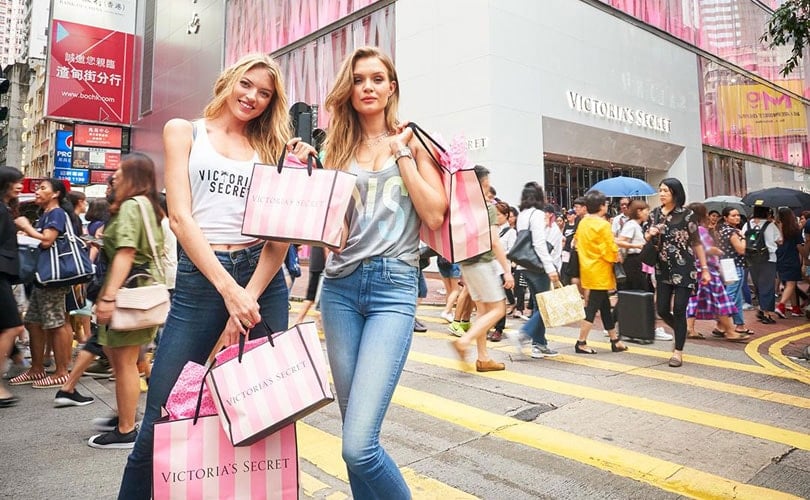
Victoria's Secret named 2nd most successful U.S. brand in new study
Content Courtesy of: fashionunited.uk
Written by: Robyn Turk
Media company 24/7 Tempo researched several metrics surrounding U.S.-owned fashion brands to determine America's place within the fashion industry. Analyzing revenue, number of stores, name recognition and metrics involving foot traffic from intelligence company Placed, store number, revenue, and other measures of success, 24/7 Tempo has ranked the 20 most successful American fashion companies.
Its research, which was published on 24/7 Tempo's website, has determined that the most successful U.S. brands are distinguished by their longevity, practicality, ease of wear and ability to cater to a wide consumer base.
24/7 Tempo ranks Brooks Brothers at place 20 due to its 500 plus stores worldwide and a revenue of 1 billion dollars. Ahead of Brooks Brothers are Converse at place 19, Tommy Hilfiger at 18 and Kate Spade at 17.
With 3.7 billion dollars in revenue and over 4,000 stores worldwide, Calvin Klein comes in at number 16. 24/7 Tempo noted that boundary-pushing ads and a wide range of product categories has helped build brand recognition in the company's five decade lifespan. Eddie Bauer, Vans and Under Armour, J.Crew and Polo Ralph Lauren follow Calvin Klein, in that order.
The 10 most successful U.S. fashion brands
According to 24/7 Tempo's analysis, the ten most successful American fashion brands are those with highly recognizable brand identities and product ranges.
Heritage denim company Levi's came in in tenth place, just behind teen-favorites Abercombie & Fitch and Hollister, which are both owned by parent company Abercrombie & Fitch Co. Nike landed seventh place, with 37.2 billion dollars in revenue and 951 stores worldwide.
Three of the brands in the top ten list are owned by Gap Inc. These are Banana Republic in sixth place, Gap in third place and Old Navy in first place, while Coach holds fifth place and American Eagle Outfitters fourth place.
Perhaps surprisingly, Victoria's Secret was named as the second most successful American fashion brand. The brand has seemed to struggle lately as it encounters growing competition in the lingerie field. Parent company L Brands has been reporting sales declines and Victoria's Secret has shared plans to downsize.

Meet Alkhemist, the brand creating everyday basics using hemp
Content Courtesy of: fashionunited.uk
Written by: Dale Arden Chong
Though cotton has been the main fiber found in denim and T-shirts, Alkhemist by James Jeans is exploring another option: hemp. Using hemp as a sustainable alternative to create its Hemp Incorporated pieces, the fashion brand — which is a division under the Los Angeles-based licensed and certified cannabis cultivation facility Alkhemist — has created a debut collection that includes jeans, shorts, jackets, T-shirts, tank tops, cargo pants, and more.
Alkhemist pieces are currently available on the brand’s website and ranges from 56 USD to 320 USD.
Below, Alkhemist co-founder Conrad Yun discusses how Alkhemist got started, what customers can expect, and more.

Tell us about how you came up with the idea to create Alkhemist.
We were looking at using hemp as a source material for our apparel lines over the last few years. With the growing interest in hemp spurred by the passage of the Hemp Farming Act of 2018 in December last year, we felt the timing was right to launch our hemp incorporated apparel lines under the Alkhemist brand name. Under the Alkhemist brand, we are also creating other product lines that use all parts of the hemp plant, such as fashion jewelry and other consumer products made from hemp plastic and hemp paper derived from the stem of the plant as well as CBD infused edible products derived from the flower of the plant.
What have you discovered through the process of developing the hemp blend you use in your clothing?
We are making new discoveries on a regular basis since we first started looking at hemp-blended materials several years ago. We are encouraged that with the excitement around hemp since the Hemp Farming Act of 2018 was passed in December 2018, more suppliers are looking to develop higher quality hemp blended materials for use in the fashion industry as well as other industries. The technology continues to improve at a rapid pace.
How does using hemp in your clothing differ from traditional cotton and other areas of traditional clothing?
In many ways, we are hearkening back to 300 years of traditions in our country. Hemp had been an important source material for everyday items such as clothing, paper, rope, and lamp oil since the founding of our country. What makes hemp exciting now is that with the liberalization of hemp and CBD in 2018 and the rapidly changing attitudes toward cannabis (which, taxonomically speaking, is the same plant as hemp), people are becoming more intrigued by what hemp can do for the apparel industry as well as for many other industries such as agriculture, health & wellness, and construction, to name a few.

Right now, Alkhemist only offers women's clothing, which ranges from denim to cotton shirts and loungewear — do you have any plans on expanding? Yes, we will be expanding into additional "hempleisure" products using a variety of blended materials, as well as a line of men's clothing.
What can people expect when trying Alkhemist pieces for the first time? Our customers can expect the same great fit, quality and style that has kept people coming back to buy James Jeans products for the last 15 years. All of the Alkhemist hemp incorporated pieces essentially have the same texture and feel as the cotton products but offer much improved durability, anti-microbial properties and other eco-friendly benefits of hemp.
TECH
Facebook’s Dating App Is Launching In The US. Here’s How It Works.
Content Courtesy of: buzzfeednews.com
Written by:
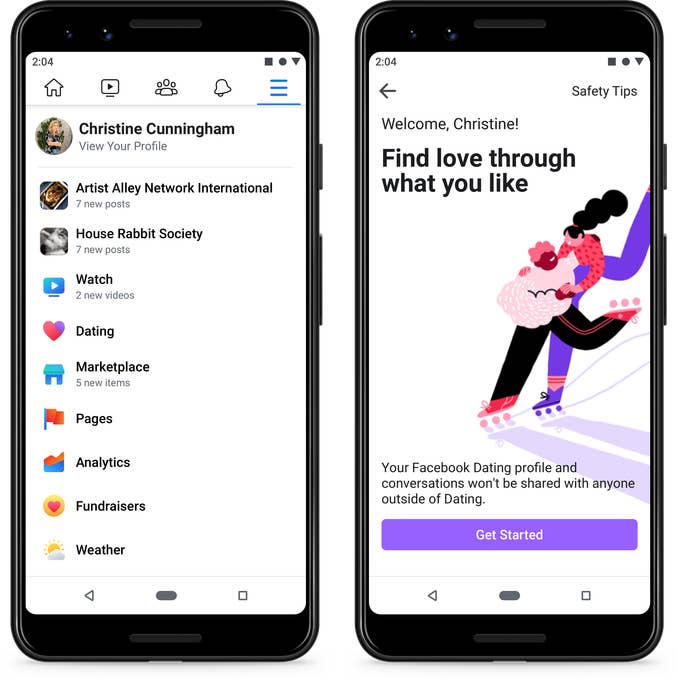
Facebook on Thursday announced the US debut of its dating service, which had previously only been available in Colombia. Facebook Dating is now available to users who are 18 and older, and it will not match you with your preexisting Facebook friends.
Facebook Dating requires opting in to the service, and it isn’t really part of your Facebook profile. You must create a separate Dating profile which is then linked to your Facebook and Instagram profiles. You fill out the profile, as you would on services like OkCupid or Bumble, and it will start matching you with people who have similar interests.
It will allow you to link your Instagram profile, which would allow you to pull in Instagram photos. It will eventually allow users to pull stories from Facebook and Instagram as well.
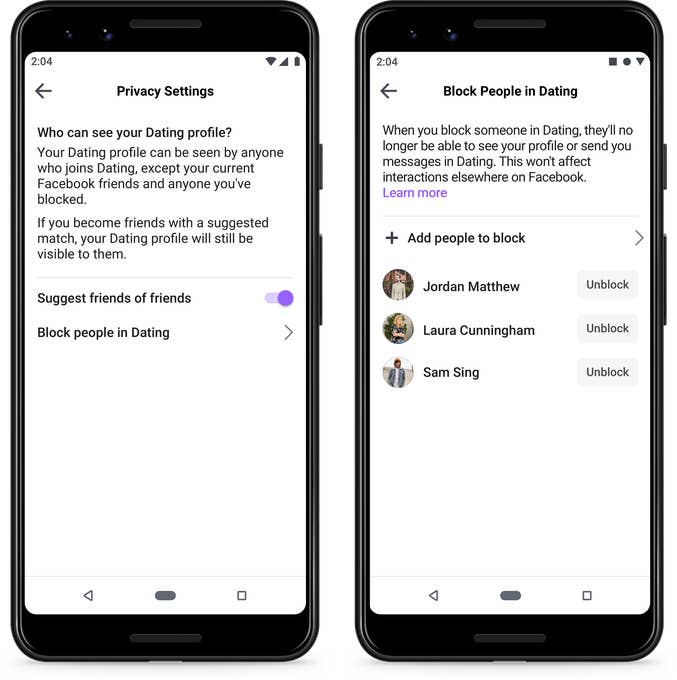
Facebook Dating also integrates with Groups and Events that you are part of. Product manager Nathan Sharp at a launch event Thursday described Facebook Events as “missed connections.” The dating app will also allow you to share your live location.
Obviously, there are a bevy of security concerns with something like this. According to Facebook’s release announcement, you can delete your dating profile at any time, and it will allow you to toggle what details it displays, including hometown, religion, occupation, and gender.
“We’re committed to protecting people’s privacy within Facebook Dating so that we can create a place where people feel comfortable looking for a date and starting meaningful relationships,” Erin Egan, VP and chief privacy officer said in a blog post Thursday.
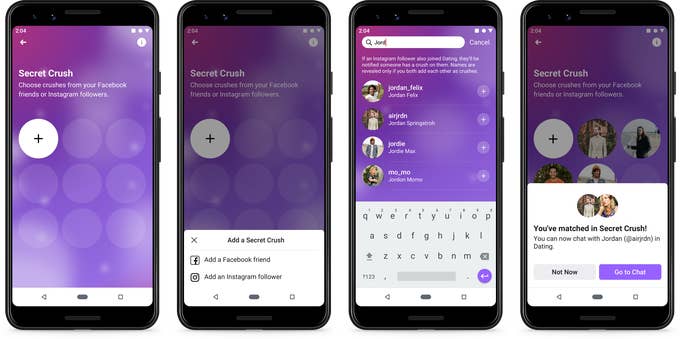
While Facebook Dating won’t match you with your Facebook friends — which means you won’t accidentally see your uncle on there — it does have a feature called Secret Crush that will let you flirt with people you already know. Secret Crush lets you choose up to nine friends to label as a crush. If one of those nine friends adds you as well, it notifies you.
Facebook Dating lives entirely on the Facebook mobile app. It also doesn’t require users to match before sending messages.
Also, in case you’re worried about accidentally letting all your friends and family know you’re on the prowl: Facebook Dating is siloed entirely from your News Feed, eliminating all risks of being horny on main.
Amazon’s Next-Day Delivery Has Brought Chaos And Carnage To America’s Streets — But The World’s Biggest Retailer Has A System To Escape The Blame
Deaths and devastating injuries. A litany of labor violations. Drivers forced to urinate in their vans. Here is how Amazon’s gigantic, decentralized, next-day delivery network brought chaos, exploitation, and danger to communities across America.
aldimar Gray was delivering packages for Amazon at the height of the pre-Christmas rush when his three-ton van barreled into an 84-year-old grandmother, crushing her diaphragm, shattering several ribs, and fracturing her skull.
“Oh my god!” screamed Gray as he leaped out of his van. It was a bright, clear afternoon on Dec. 22, 2016, and the 29-year-old had been at the wheel of the white Nissan since early that morning, racing to drop Amazon packages on doorsteps throughout Chicago. He stood in anguish next to Telesfora Escamilla as she lay dying, her blood pooling on the pavement just three blocks from her home. After the police arrived, Gray submitted to drug and alcohol tests, which came up clean. He would later be charged with reckless homicide.
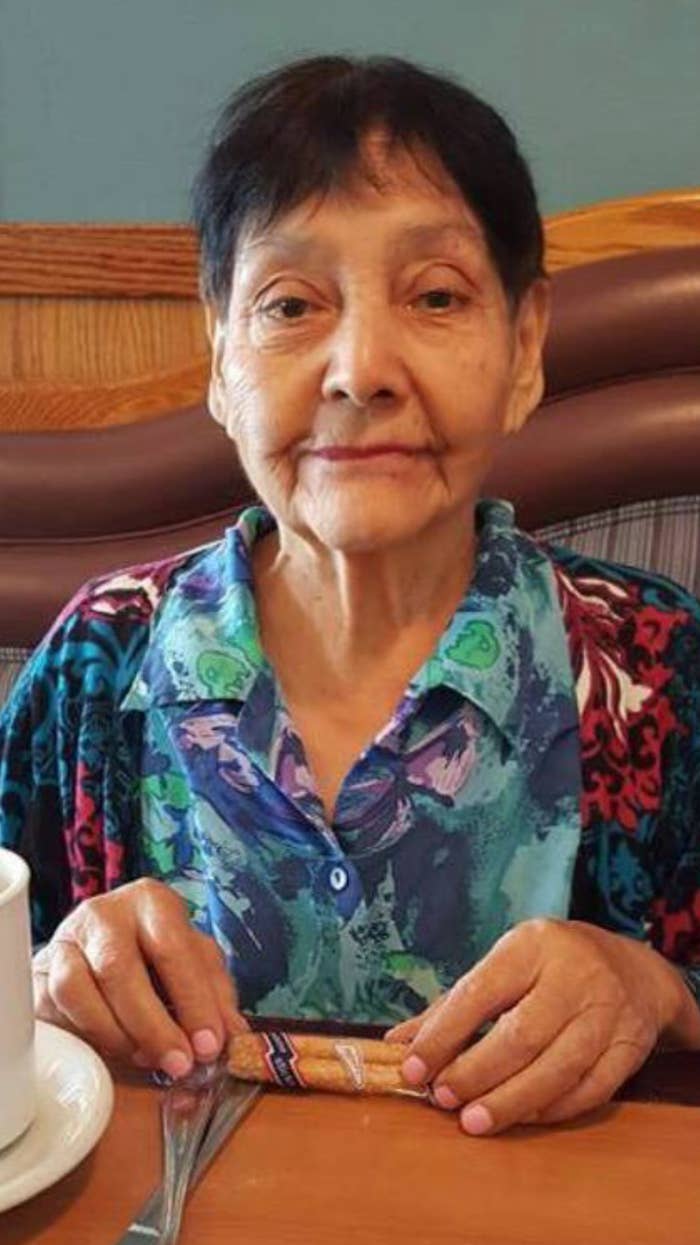
The officers who investigated the crash didn’t ask Gray about the constant pressure for speed he faced as a driver for Inpax Shipping Solutions — one of hundreds of small companies that make up Amazon’s gigantic delivery network across America. If they had, they would have discovered that the company’s drivers worked under relentless demands to deliver hundreds of packages each shift — for a flat rate of around $160 a day — at the direction of dispatchers who often compel them to skip meals, bathroom breaks, and any other form of rest, discouraging them from going home until the very last box is delivered.
Amazon issued Inpax hand scanners that could monitor the progress of its drivers as they delivered their packages and dictated the routes they drove. It had sent Gray’s bosses at Inpax a memo just days before the accident, criticizing lackluster delivery rates in the area and instituting a “no package left behind” policy during the critical holiday week. The number of deliveries drivers were expected to make each day was way up, and dispatchers were urged to keep as many of their vans on the road for as long as possible — even if it meant driving long into the bitter winter night.
But when Escamilla’s grieving family sought redress — suing Amazon, Inpax, and Gray for wrongful death — the e-commerce giant refused to accept any responsibility. “The damages, if any, were caused, in whole or in part, by third parties not under the direction or control of Amazon.com,” its lawyers said in a court filing.
Inpax had by then been repeatedly cited by the Department of Labor for withholding pay from its drivers. Its owner had several cocaine-related felony convictions and had previously declared bankruptcy after missing insurance payments, failing to pay taxes, and defaulting on loans and other obligations amounting to $15 million. And the company was struggling to make ends meet on the razor-thin margins of a system set up by Amazon to squeeze contractors while minimizing its own costs at every turn.
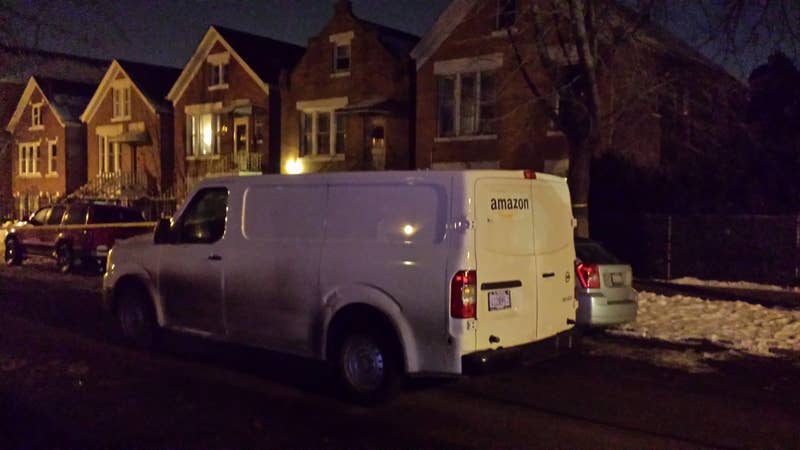
Just months before Escamilla’s death, a former employee told BuzzFeed News, Inpax had stopped paying for a critical safety monitoring service it had installed in every van in Chicago — equipment some felt could have helped prevent the accident.
But despite Inpax’s checkered record, after denying any blame for Escamilla’s death, Amazon continued using the company to deliver its packages across Chicago and at least four other major cities. Inpax did not respond to a detailed written request for comment.
The super-pressurized, chaotic atmosphere leading up to that tragedy was hardly unique to Inpax, to Chicago, or to the holiday crunch. Amazon is the biggest retailer on the planet — with customers in 180 countries — and in its relentless bid to offer ever-faster delivery at ever-lower costs, it has built a national delivery system from the ground up. In under six years, Amazon has created a sprawling, decentralized network of thousands of vans operating in and around nearly every major metropolitan area in the country, dropping nearly 5 million packages on America’s doorsteps seven days a week.
Amazon drivers say they often have to deliver upward of 250 packages a day — and sometimes far more than that — which works out to a dizzying pace of less than two minutes per package based on an eight-hour shift.
The system sheds costs and liability, even as it grows at lightning speed, by using stand-alone companies such as Inpax to pick up packages directly from Amazon facilities and deliver them to the consumer — covering what’s known in the industry as “the last mile.” Amazon goes further than gig economy companies such as Uber, which insist its drivers are independent contractors with no rights as employees. By contracting instead with third-party companies, which in turn employ drivers, Amazon divorces itself from the people delivering its packages.
That means when things go wrong, as they often do under the intense pressure created by Amazon’s punishing targets — when workers are abused or underpaid, when overstretched delivery companies fall into bankruptcy, or when innocent people are killed or maimed by errant drivers — the system allows Amazon to wash its hands of any responsibility.
Amazon still relies on UPS and the US Postal Service for many deliveries. And it has captured the public imagination with press releases about futuristic drone delivery, which does not yet exist. But it’s this homegrown network that makes it possible to offer the amazing convenience of next-day and even same-day delivery that has become a cornerstone of its market dominance. By some estimates, nearly half of Amazon's packages in the US are now delivered this way. And the Seattle-based giant dictates almost every aspect of that operation, down to what drivers wear, what vans they use, what routes they follow, and how many packages they must deliver each day.
Amazon says its role is to lend entrepreneurs a hand as they build small businesses and not to control their companies, equipment, or labor force. It said it does not make personnel decisions for them, and while it offers them the opportunity to lease vans, purchase insurance, and manage payroll through its preferred programs, they are free to use whichever vendors they choose.
In response to a detailed list of questions from BuzzFeed News, it said that because many of the cases mentioned in this article are in active litigation, it cannot discuss them in detail. However, the company said safety is always its top priority and that even one serious incident is too many. It says that when accidents occur, it works with drivers or their employers to investigate claims and take appropriate actions.
In a written statement about the article's findings, the company said: The assertions do not provide an accurate representation of Amazon’s commitment to safety and all the measures we take to ensure millions of packages are delivered to customers without incident. Whether it’s state-of-the art telemetrics and advanced safety technology in last-mile vans, driver safety training programs, or continuous improvements within our mapping and routing technology, we have invested tens of millions of dollars in safety mechanisms across our network, and regularly communicate safety best practices to drivers. We are committed to greater investments and management focus to continuously improve our safety performance.
Six days after publication of this article, Amazon issued an additional statement: "We require that all delivery service partners maintain comprehensive insurance, including auto liability so if in the rare case an accident does occur, there is coverage for all involved."
UPS and FedEx, the traditional powers of the logistics world, are deeply invested in safety. UPS, which spends $175 million a year on safety training alone, even has a policy prohibiting drivers from taking unnecessary left turns to reduce exposure to oncoming traffic, finish routes faster, and save fuel. Both firms are also heavily regulated by the government, and many of their trucks are subject to regular federal safety inspections and can be put out of service at any time by the Department of Transportation.
But Amazon’s ingenious system has allowed it to avoid that kind of scrutiny. There is no public listing of which firms are part of its delivery network, and the ubiquitous cargo vans their drivers use are not subject to DOT oversight. But by interviewing drivers as well as reviewing job boards, classified listings, online forums, lawsuits, and media reports, BuzzFeed News identified at least 250 companies that appear to work or have worked as contracted delivery providers for Amazon. The company said it has enabled the creation of at least 200 new delivery firms in the past year, a third of which are owned and run by military veterans. Inpax gets fully 70% of its business from Amazon; some companies depend on the retail giant for all of their income.
With little training, and often piloting vans in dangerous states of disrepair, Amazon drivers have crashed into cars, bicycles, houses, people, and pets.
A yearlong investigation — based on that data, along with internal documents, government records, thousands of court files, and interviews with dozens of current and former Amazon employees, delivery company operators, managers, and drivers — reveals that Amazon’s pivot to delivery has, all too often, exposed communities across the country to chaos, exploitative working conditions, and, in many cases, peril.
Public records document hundreds of road wrecks involving vehicles delivering Amazon packages in the past five years, with Amazon itself named as a defendant in at least 100 lawsuits filed in the wake of accidents, including at least six fatalities and numerous serious injuries. This is almost certainly a vast undercount, as many accidents involving vehicles carrying Amazon packages are not reported in a way that can link them to the company. And in some states, including California, accident reports are not public.
The deaths have included victims as old as Escamilla and as young as a 10-month-old baby named Gabrielle. Often with little training, and at times piloting vans in dangerous states of disrepair, Amazon drivers have crashed into cars, bicycles, houses, people, and pets. And under constant pressure to deliver ever more packages, drivers have piled parcels so high on their dashboards that they couldn’t see out the windshield — causing at least one serious collision.
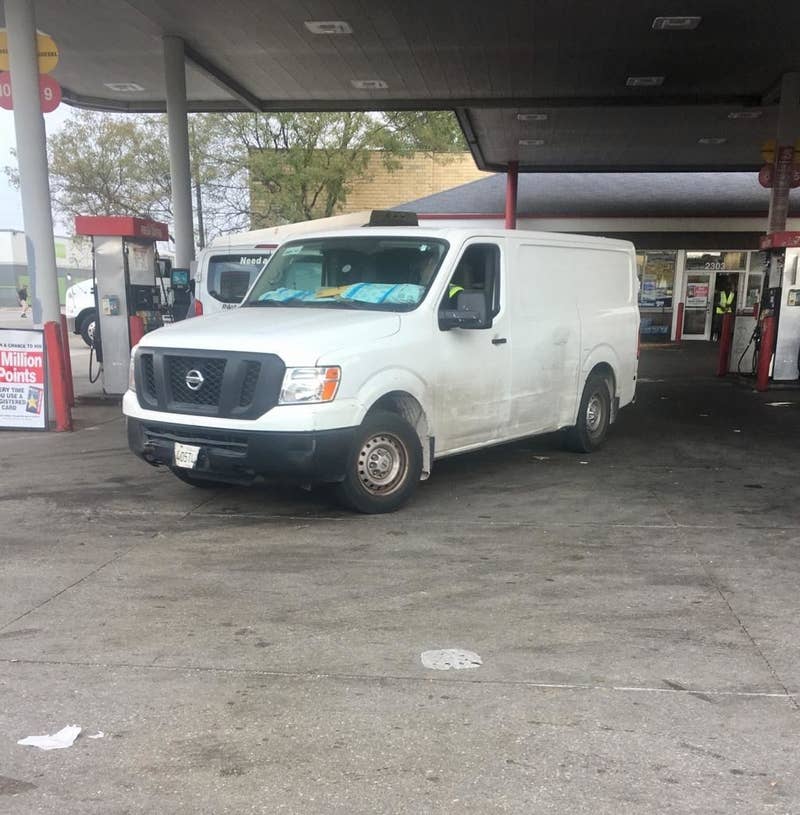
In some of the cases in which Amazon was sued over road accidents, the drivers had been allowed to take the wheel despite previous convictions for traffic infractions.
Delivering packages for Amazon can itself be a perilous job. Drivers have reportedly been punched, bitten, carjacked, robbed, and shot — and at least two have died in recent years as a result of road accidents that occurred on the job.
Amazon denies any responsibility for the conditions in which drivers work, but it has continued to contract with at least a dozen companies that have been repeatedly sued or cited by regulators for alleged labor violations, including failing to pay overtime, denying workers breaks, discrimination, sexual harassment, and other forms of employee mistreatment.
And when one group in Michigan voted to join the teamsters in protest against shoddy conditions and punishing hours without overtime pay, Amazon officials acted swiftly to counter further unionization efforts.
In Southern California, Illinois, and Texas, Amazon continues to work with a firm beset by a staggering array of lawsuits from its own drivers, who said they weren’t paid properly, and from pedestrians, motorists, and cyclists, who said they were injured in collisions with the company’s trucks — even after its chief executive was accused by the firm’s own CFO of embezzling more than $1.5 million to fund an apparent gambling spree in Las Vegas.
Two drivers for a different delivery company operating in the Los Angeles area said they were forced to skip meals, ordered to urinate in bottles rather than stop for bathroom breaks, and advised to speed and not wear seatbelts to ensure they delivered more packages in less time.
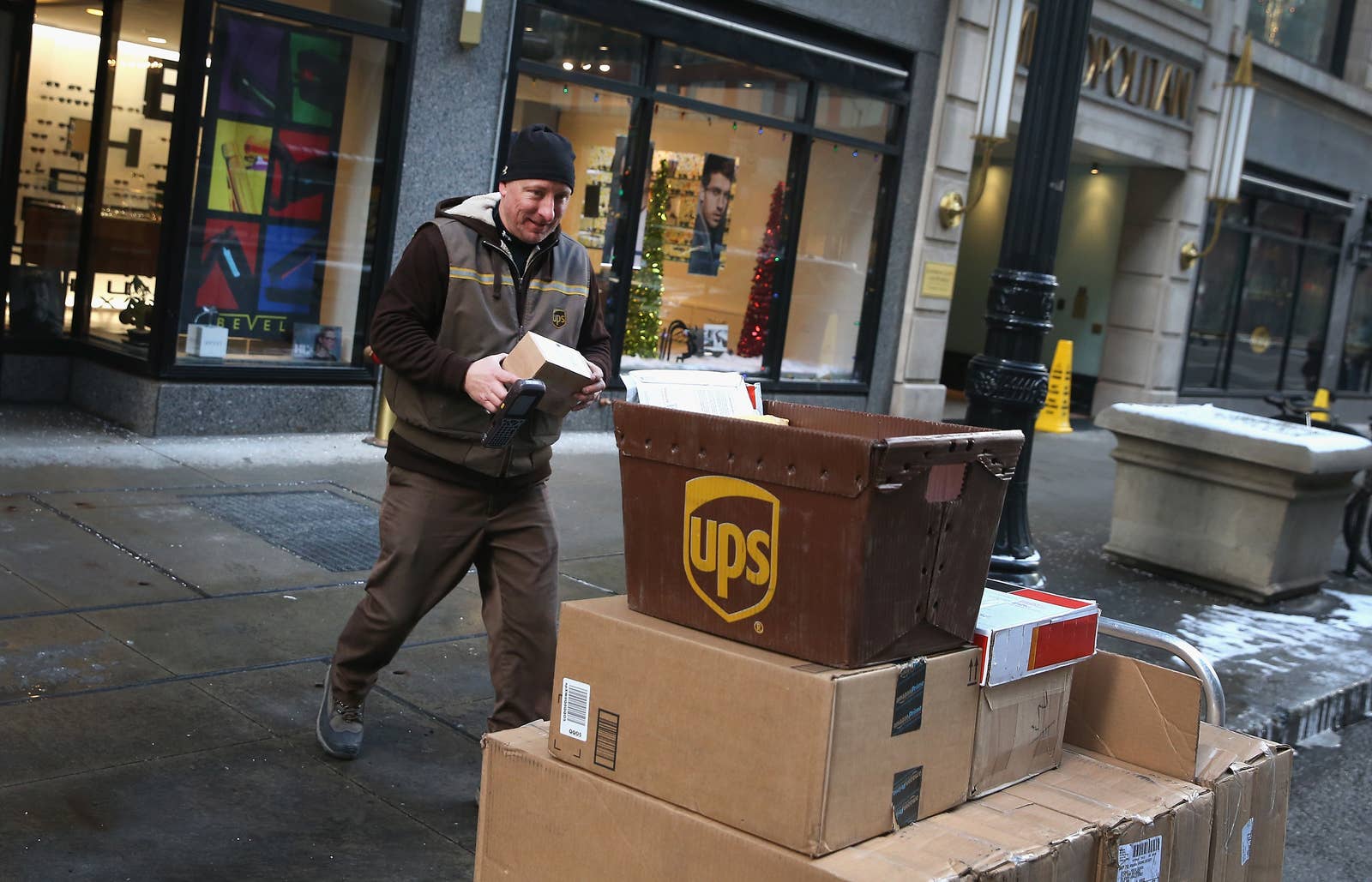
A UPS worker delivers packages on Dec. 26, 2013, in Chicago.
Amazon’s gargantuan delivery network was born after a notorious incident remembered in the corridors of the company’s Seattle headquarters as the “Christmas Fiasco” of 2013. As e-commerce began to boom and the holiday loomed, UPS and FedEx, which then delivered the bulk of Amazon’s packages along with the US Postal Service, were blindsided by the large volume of online orders and failed to deliver many parcels by Dec. 25.
Furious, embarrassed, and determined that such an incident would never happen again, Amazon gave affected customers $20 gift cards while its executives hatched a bold and disruptive plan to free themselves from overdependence on the large, established carriers. They would develop a network of small and midsize delivery companies to take over key routes, working directly out of special Amazon delivery stations, rather than UPS or FedEx facilities, and delivering packages according to Amazon’s own routing algorithms.
The goal, according to people with knowledge of Amazon’s operations — including a former executive who helped oversee the program in its early days — was to build out a completely independent last-mile delivery system. The company said it did so because of growing demand from customers, but continues to work with established delivery companies as well.
Amazon would offer small delivery companies, many of them brand-new, a chunk of its booming e-commerce business, and in exchange would be able to wield unprecedented leverage over their logistics operations. It would also have the power to squeeze costs down in a way it never could working with behemoths such as FedEx and UPS.
Under this new system, Amazon would be able to closely monitor drivers through its routing software. It would make entrepreneurs assume the financial risk of running a delivery business. And perhaps most crucially, because the drivers would be employed by independent companies, Amazon would be able to assert it had no legal liability for their working conditions — or for any mayhem employees wrought as they raced to hit delivery targets requiring more than 99% of packages to arrive by their promised delivery date.
In short order, fleets of anonymous-looking gray-and-white vans were dashing through the streets of communities across America, stopping every few blocks to disgorge books, electronic gadgets, boxes of toilet paper, and the myriad other items that people increasingly order online.
For consumers, the change was hardly perceptible — unless they happened to look out their windows and notice that the familiar brown of the UPS truck and the cheerful orange and purple of FedEx came less often, replaced by slightly smaller vans that often had no markings at all.
But behind the wheel, and out on the streets, the changes were enormous.
Even though the Sprinter-style vans Amazon requires its delivery providers to use weigh several times more than most passenger cars, they fall just under the weight limit that would subject them and their drivers to Department of Transportation oversight, unlike most FedEx and UPS trucks.
In a sign of how business is booming, Amazon last summer bought 20,000 of these vans from Mercedes-Benz to be leased, through fleet managers, to its dedicated delivery companies around the country.
Applicants for jobs at UPS and FedEx are thoroughly screened and cram for challenging entrance exams before being hired. They undergo rigorous training that can last for weeks or longer, depending on the position, and are required to undergo additional training every year. Even the most minor fender benders trigger internal investigations that seek to identify who was at fault and how such accidents can be avoided in the future.
UPS, which is unionized, uses routing software programmed to minimize most left-hand and other dangerous turns. As part of their training, its drivers must go through special protocols before making certain maneuvers, such as backing up their trucks.
Amazon says it spends tens of millions of dollars on safety, and in some of its contracts with delivery companies, it demands that every driver pass a background check and drug test, have at least six months’ experience, and pass an extended road test. Job postings by firms delivering Amazon packages, however, say commercial driver's licenses and prior experience aren’t necessary. Drivers are paid either a flat day rate or an hourly wage — which generally works out to between $15 and $18 an hour, with scant perks or benefits. With constant alternation between driving and loading and unloading packages, the job is physically demanding.
One of the first companies ushered in under Amazon’s new delivery regime was Progistics Distribution, an already operating San Francisco–based logistics firm that agreed to dedicate a portion of its fleet to Amazon packages. Jose Guillermo Perez was hired by the company as a driver in spring of 2014, soon after the Christmas Fiasco.
After two days of in-office training, Perez was sent onto the hilly, chaotic streets of San Francisco riding shotgun alongside a more experienced driver to learn the ropes. Things almost immediately went haywire. Just after lunch on the first day, Perez was astonished to find the driver backing into a light post, then speeding away from the scene as if the accident hadn’t happened, without even checking for damage. After that, Perez said in an interview, things got worse. The driver continued to ignore the speed limit and blew through stop signs as he shot up and down traffic-choked streets.
“Dude, you need to be careful; I want to get back safe,” Perez recalled saying. “I don’t want to die, man.”
But the driver, Jim Kitamura, told Perez he had to hurry.
Shortly after 3 p.m., their Ford van approached a busy intersection in a residential neighborhood just as the light turned red. Rather than hit the brakes, Kitamura kept going, heading straight for a motorcycle that was accelerating through the crossing. A driver in another car noticed and honked frantically in warning, but the delivery van kept going and smashed into the bike, according to a police report.
The impact was so powerful that it not only knocked Paul Hon Chow Lee off the motorcycle — fracturing his ankle, pelvis, and six ribs — but also knocked his shoes clean off his feet, according to the police report.
Even before the crash, the events of the day had given Perez cause for alarm. He saw that drivers were given huge piles of packages to deliver and were barraged by constant nagging calls from dispatchers checking in on their progress. The vans, he thought, were in terrible shape, with worn tires and sagging suspensions, and he said he’d witnessed at least one driver smoking marijuana on the job. Perez said Progistics hadn’t done a drug test on him, and could not recall any other screening process.
Progistics did not respond to a detailed request for comment.
Police cited Kitamura for running a red light. It was far from his first driving violation. In the eight years leading up to the accident, Kitamura had been pulled over at least four times, records show, twice pleading guilty to driving more than 20 mph over the speed limit — once in 2006 and once in 2008 — and once to running a stop sign in 2011. He’d also been charged with sex crimes involving minors and was a registered sex offender.
So concluded Perez’s training.
The first day he was sent out on his own, he quit before the shift was over.
“I thought, No, this is crazy. I had 160 packages and it was raining; you can’t even see,” he said. “I did, like, probably half of it and I took the truck back and went and told the guy, ‘This is it. I’m done.’”
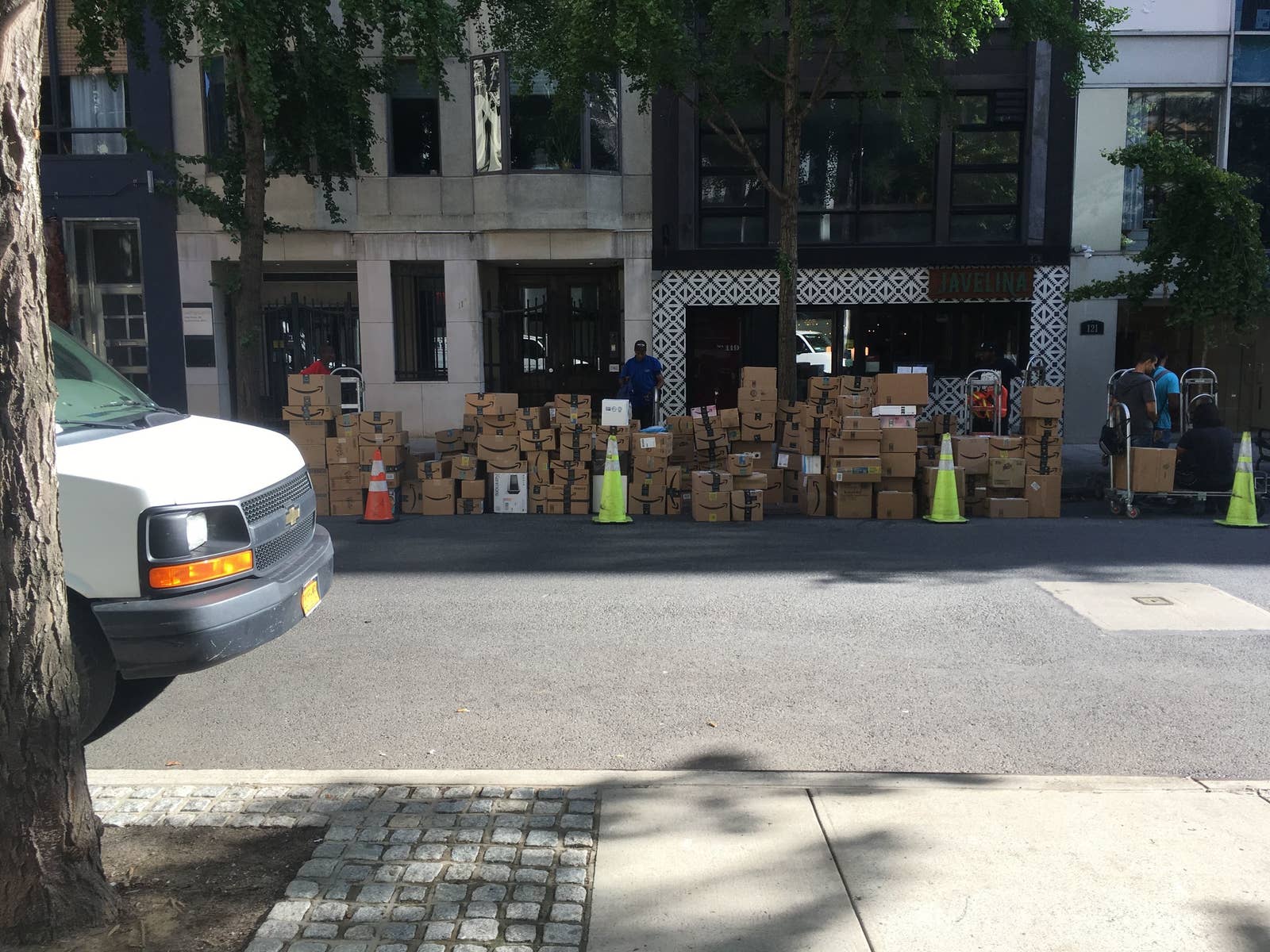
Workers unload packages onto the street for delivery in New York City on Aug. 30.
In the five years since it dove into last-mile delivery, Amazon’s business has boomed.
In 2018, its retail sales hit a record $233 billion, and this year it surpassed Walmart as the largest retailer in the world. In April, it promised free one-day shipping for all its Prime members — an unprecedented logistical challenge.
Not all of Amazon’s packages are carried by its network of small providers; it continues to rely on UPS and the US Postal Service for many of its deliveries, particularly for bulky packages or for rural, harder-to-reach destinations. But with FedEx recently canceling its contract to deliver Amazon packages, a growing share of the huge delivery load is being carried by the network of tiny, lightly regulated firms in its vast national network.
Delivering billions of packages a year is by far one of the company’s top expenditures. But Amazon can better control those costs by squeezing its own delivery network. It not only can track every package but also can monitor payroll, insurance, and even van leasing costs for many of its delivery companies. That allows it to keep an eye on companies’ profit margins and adjust accordingly. Early this year, for example, Amazon stopped paying delivery companies extra money to cover the cost of a dispatcher in each delivery station, requiring the companies to pay that salary out of already thin margins or operate without them.
Amazon pays many of its delivery firms a flat fee per route, so when package volumes increase and drivers need to be out on the road for longer, racking up more overtime, their margins are squeezed even tighter. One contract for a route in San Francisco reviewed by BuzzFeed News, for example, called for a fee of $279.50 per day. That money must cover the cost of the van, insurance, and any other overhead, plus the driver’s wages. Some newer delivery firms are paid a per-route fee, plus a per-package fee.
Many of them have no source of income other than Amazon and, faced with those circumstances, can find they have no choice but to cut back wherever they can.
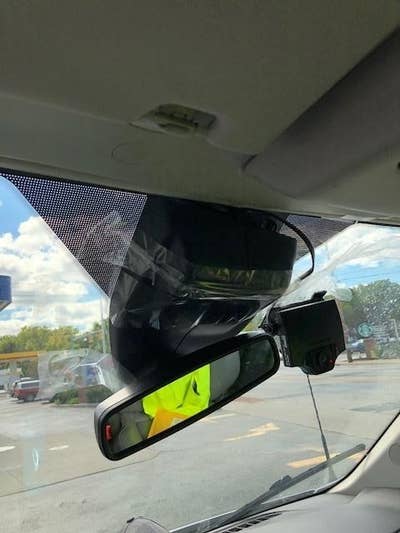

A taped-on rearview mirror and balding tires on a delivery vehicle.
Drivers complain of poorly maintained vans, with underinflated and balding tires, cracked or missing sideview mirrors, and, in one case, doors that had to be held shut with bungee cords. Frequently they have no backup cameras, and many don’t even have a rear window. As a result, some drivers back into things — lawns, mailboxes, parked cars, and, sometimes, people.
And then there are the corners drivers themselves cut to finish their deliveries on time and keep dispatchers off their backs. Drivers complain they are sometimes given so many packages that they don't all fit in the cargo area and must be piled on the passenger seat. Some said they pile packages on the dashboard to save the time it takes to walk around to the rear of their vans for each delivery. Having the parcels laid out at their fingertips, they explained, helps them get through their routes more quickly and avoid the wrath of impatient dispatchers. But that convenience comes at a cost.
Resty Evinger was pulling out of a parking space outside an apartment complex in Austin in March 2018 when she collided with Julia Barrera Duran. The 62-year-old was knocked to the ground, and her head hit the asphalt. According to claims in a pending lawsuit filed by Duran, Evinger had her left foot in a medical boot and walked with crutches. She quickly got out of the Dodge Ram van and knelt by Duran’s side. According to a police report, Evinger explained why she hadn’t seen Duran in broad daylight: Her view had been partially obstructed by a pile of Amazon packages arranged on the dashboard.
Amazon said that it considers a variety of factors when considering the size of loads, but said it is up to drivers to determine how to pack the vans and where to put the packages. If a driver is worried about the number of packages they are given, they are welcome to raise those concerns.
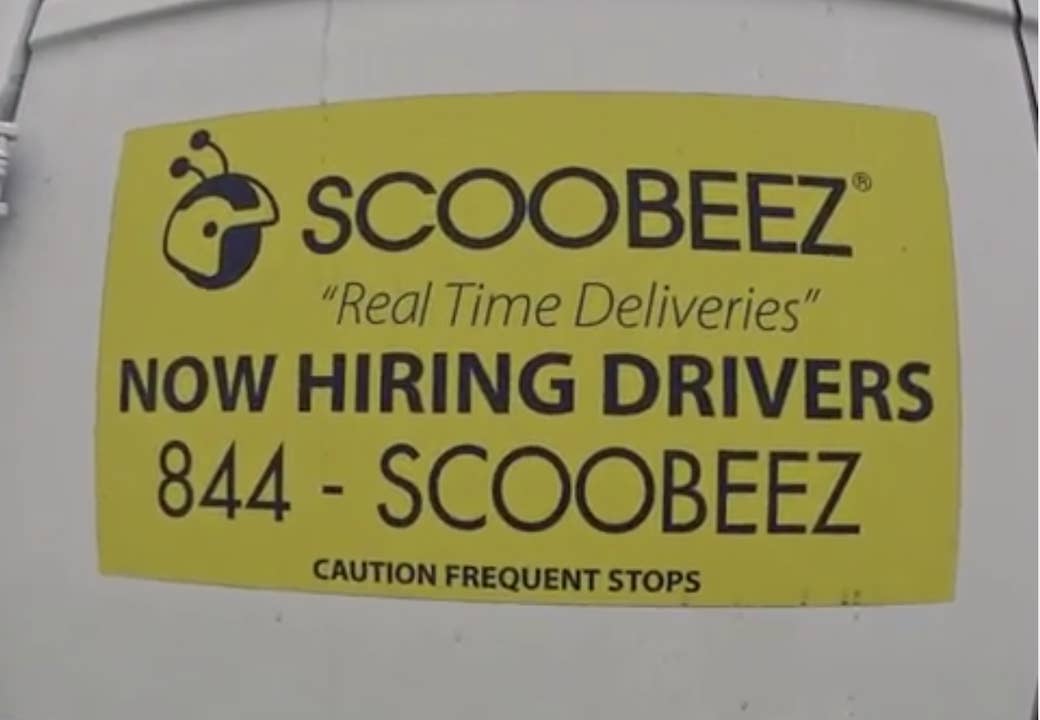
Amazon can surveil almost every driver in its delivery network. But when it comes to the pedigree of the companies it entrusts to deliver its cargo, officials are remarkably hands-off, overlooking serious safety lapses, criminal convictions, and egregious violations of labor laws.
Amazon said it expects its delivery operators to comply with the law.
In July 2015, an obscure mining firm in Idaho abruptly changed ownership and announced it was getting into the package delivery business for Amazon, under the unlikely new name of Scoobeez.
Just months after making its first deliveries, however, the company was who successfully claimed they had been misclassified as contractors rather than employees. It would be the first in a string of employment, personal injury, contract, and workplace discrimination lawsuits filed against the firm.
In March 2017, the company’s CFO sent a 25-page report to the Scoobeez board of directors alleging that CEO Shahan Ohanessian had misappropriated as much as $1.5 million of the company’s funds, transferring the money to his own bank accounts and withdrawing hundreds of thousand of dollars of that money at the Wynn hotel and casino in Las Vegas. Subsequent investigations concluded that Ohanessian then took out 17 high-interest loans to cover his tracks, costing the company some $2 million in fees and interest payments — money that might have been used to pay the drivers who were suing the company for unpaid overtime or, for example, the Texas family who came home one day to find that a Scoobeez van had rolled down their driveway and into their house, smashing the side of their attached garage
.In April, Scoobeez filed for bankruptcy protection, listing, among other liabilities, monthly payments totaling nearly $7,000 for leased Bentley, Porsche, and Mercedes-Benz luxury vehicles that were made available to the company’s top executives.
Scoobeez denied, in a separate court filing, the former CFO’s embezzlement allegations, saying they were fabricated and part of a ploy to take control of the company. Ashley McDow, an attorney representing Scoobeez in its ongoing bankruptcy, said the company had nothing to add beyond what is in the public record.
As of late August, the company continues to recruit delivery drivers for locations throughout Southern California, Illinois, and Texas — and in court records, it has claimed that 99% of its revenue comes from Amazon. Newly filed personal injury lawsuits continue to roll in, and in May, Enterprise sued Scoobeez, claiming it owed it more than $700,000 for damages to vans it had leased the company.
Ohanessian and his wife are no longer with Scoobeez and lately have turned to another possible get-rich scheme: putting logistics on the blockchain
.In 2017, Courier Distribution Systems, another of Amazon’s larger delivery providers, was notified by Inc. magazine that it was one of the 500 fastest-growing privately held startups in the country. “Welcome,” the magazine’s editor-in-chief wrote in a congratulatory letter, “to the most exclusive club in business!”
Like other Amazon delivery companies, CDS — based outside of Atlanta but delivering Amazon packages in several states, including Wisconsin, California, Pennsylvania, and Illinois — was required to carry a full slate of insurance.
In addition to cargo, business, and general legal liability coverage, Amazon requires delivery firms to carry workers' compensation policies, which are designed to cover the costs of medical care for employees injured on the job as well as any lost wages.
But that system failed Aleasa Thomas, who worked for CDS in the Milwaukee area. In April 2017, while completing a delivery to a house, Thomas said, she was violently attacked by a dog, causing her to fall and hit her head.
Only later did Thomas discover that CDS — which had earned its place on the Inc. list by growing at least 10 times larger over the previous three years — had failed to pay its workers' compensation premiums in Wisconsin between February and June of 2017, meaning she was not covered. CDS was later hit with a $154,000 judgment for failing to pay workers' compensation insurance in the state.
Jim Blanchard, a CDS representative, acknowledged the four-month insurance lapse but said it occurred while the firm was applying for different coverage. He added that CDS paid all of Thomas’s “medical bills, all of her unpaid wages, and any other losses.”
Wisconsin was far from the only region where CDS appears to have fallen fell behind on its bills. The firm has faced at least two dozen lawsuits and other claims in recent years by employees who say it didn’t correctly pay them, fired them without cause, or discriminated against them. Some of those cases settled out of court. A tire company near San Diego won an $11,578 judgment against the company in November 2017 after CDS failed to pay its bills.
Elsewhere, CDS had faced a mutiny from some of its drivers. Jovon Bray, a dispatcher at CDS in Sacramento, said he was forced to quell a near riot in October 2015 when roughly 100 angry drivers showed up to work demanding to know why they hadn’t been properly paid. When Bray called a manager at headquarters for advice, he recalled being told, “You need to find a better lie to tell them.”
“The whole thing is like a joke. They had no rules established. I asked if there was a manual or a handbook, what are my expectations? They said, ‘You gotta create them as you go.’”
When it happened again two months later, Bray said he called again and declared that he wouldn’t work unless everyone — including himself — got paid on time. A few days later, he recalled receiving a phone call from a supervisor while at a holiday party. “You aren’t management material,” Bray recalled the person telling him before summarily firing him. Bray and several other workers sued CDS and eventually settled out of court.
“The whole thing is like a joke,” Bray told BuzzFeed News. “They had no rules established. I asked if there was a manual or a handbook, what are my expectations? They said, ‘You gotta create them as you go.’”
Blanchard denied the allegations. “I assume this has been fabricated,” he said. He added that “CDS has offered good-paying jobs and benefits to thousands of employees — many of whom lacked the education or skills to secure any other job paying as much as they earned at CDS — and largely without incident or dispute.”
In the wake of the uprising, CDS lost its Sacramento routes. But Amazon continues to work with the company in numerous other cities around the country.
The same labor problems that appear across Amazon’s delivery network were apparent at Inpax in the period leading up to the crash that killed Telesfora Escamilla. Just months after Amazon began working with the firm in 2015, it fell under investigation by the Department of Labor for chronically underpaying dozens of drivers and was ordered to pay employees back wages. The following year, regulators found Inpax had “willfully violated” labor laws a second time by failing to pay drivers overtime. Third and fourth investigations would uncover more violations and unpaid wages of more than $140,000.
Inpax’s founder and CEO, Leonard Wright, had a string of cocaine-related felony convictions and first registered the company shortly after finishing a three-year prison sentence for narcotics distribution. Yet despite the mounting warnings that Inpax had serious issues, Amazon kept shoveling more business in its direction. By 2016, the firm was delivering in at least five cities — Atlanta, Cincinnati, Miami, Dallas, and Chicago — Labor Department records acquired through the Freedom of Information Act show.
As Christmas of 2016 approached, Amazon was on track for what would be its biggest holiday season to date, ultimately shipping more than 1 billion packages worldwide. To handle the record-setting workload, it piled on the pressure, ramping up the number of packages each driver was expected to deliver each day.
Although the woman escaped with minor scrapes, the dog did not survive.
By then, Inpax had eliminated numerous fleet managers whose job it had been to oversee safety and operations, according to former employees. The firm had stopped repairing vans that were damaged or had missing mirrors, cracked windows, or bald tires. And, two said, it stopped paying for a state-of-the-art fleet monitoring service it had installed in all of its vehicles that tracked their location and speed and was designed to alert fleet managers if drivers were making unsafe maneuvers.
Escamilla’s death that December was not the first or last time the company’s drivers would run into trouble on the roads. Court records show the company has been served with at least five additional accident-related lawsuits since then.
In October 2017, an Inpax van loaded with Amazon parcels came around a corner in Weston, Florida, and plowed into a cockapoo that had run into the road before the eyes of its owner and her two young sons. When the distraught woman banged on the window in outrage, the driver hit the gas, dragging her to the ground, according to a police report. Although the woman escaped with minor scrapes, the dog did not survive.

A diagram from the police report depicting an accident that killed a dog in Weston, Florida.
The driver told police that she called her manager at Inpax to report the accident and was instructed to leave immediately and return to the delivery station. Perez voluntarily returned with her Inpax manager later that day to speak with police, but she was ticketed for fleeing the scene of the accident and ordered to pay $1,500 in restitution, court records show.
The dog's owner is suing Inpax and the driver for physical and emotional damages, claiming that Perez had been “speeding down the street.” Inpax countered that the incident was solely due to her own “carelessness and negligence” in letting her dog stray into the road. Amazon was not sued; once again it escaped liability.

Traivon Hemingway, a slender 21-year-old who delivered packages in and around Chicago for Amazon delivery provider Sheard-Loman Transport, was attempting to make an exit off an interstate southwest of town on the morning of June 19, 2018, when the Ford van he was driving struck the back of a tractor trailer parked on the highway shoulder.
The force of the impact tore off the top of the van and drove the rest of the vehicle under the trailer. Emergency workers tried but failed to resuscitate Hemingway at the scene of the crash, where he died.
News of Hemingway’s death spread quickly through the Amazon delivery station on the South Side of Chicago where he’d worked, but there is no record of his death being investigated by workplace health and safety officials. News reports about the accident never linked Hemingway’s death to his work for Amazon, but a GoFundMe page set up by his sister received a $100 donation from Bill Seliger, an Amazon executive who managed delivery-firm accounts in Chicago.
Hemingway’s van was eventually returned to Sheard-Loman, which has been sued three times in the last year by former employees claiming they were cheated out of overtime and other wages. All three suits are pending.
Sheard-Loman did not respond to a written request for comment.
More than a year after his death, one of Hemingway's relatives in Chicago was still frequently posting about his death on Facebook. "Not a day goes by that I don't think of him and still cry," she wrote on Aug. 30. "Missing you so much Traivon Hemingway until we be together again."
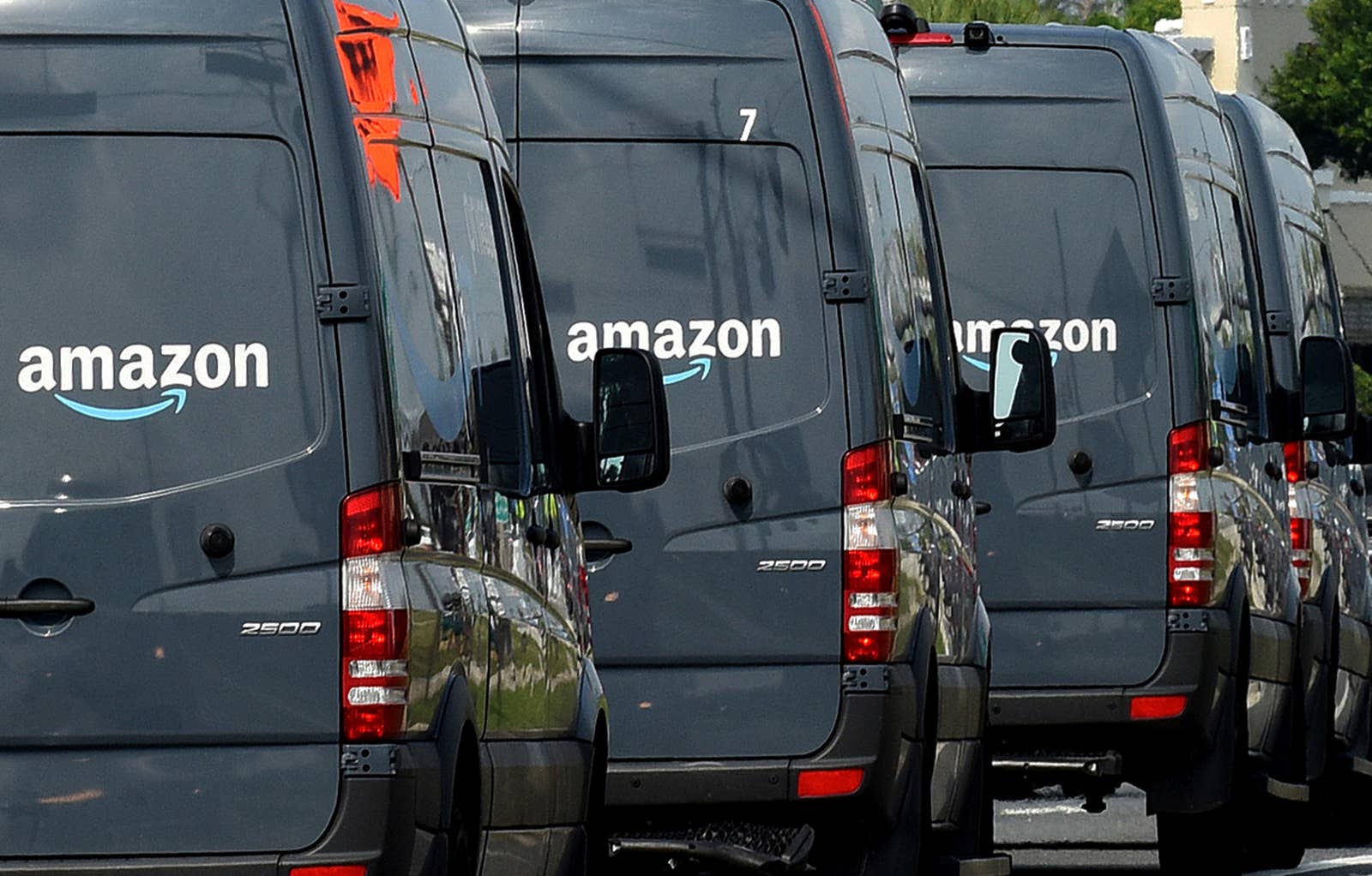
Amazon delivery vans are seen May 14 in Orlando.
When delivery drivers complain about the harsh conditions they face, Amazon refuses to admit any responsibility. But when a group of drivers banded together to advocate for their rights to fair pay and safe conditions, executives at the e-commerce giant moved quickly to quash any further such efforts.
In March 2017, a group of drivers for the delivery firm Silverstar Delivery met with a Teamsters organizer at a TGI Fridays outside of Detroit to complain about the shoddy condition of the vans they drove, Amazon GPS devices that conked out at crucial moments, and, in particular, a lack of overtime pay, despite shifts that routinely lasted as long as 12 hours.
The organizer convinced them to unionize, and the following month, Silverstar employees voted 22–7 to join the Teamsters, making it the only Amazon delivery contractor to have unionized to date.
Silverstar did not react positively to the news. Within weeks, drivers reported to the National Labor Relations Board that they were being fired for joining the union.
One of the workers claimed he was terminated in May after bringing back undelivered packages to the warehouse. When he complained, the worker said a manager told him, “I was told to write you up for anything because you joined the union,” according to NLRB filings.
The board dismissed the charges that workers were illegally fired in retaliation for unionizing, but allowed other claims of anti-union activity to proceed. Silverstar ultimately agreed to pay $15,696 to settle the matter.
The Teamsters named Amazon in their complaint, but the retailer denied having any legal relationship to the unionized workers. “While Amazon has a services contract with Silverstar, Amazon is not the employer of Silverstar’s employees,” the company wrote in a letter to the NLRB.
A few months later, Norm Collins, who had been elected shop steward, received a call from a Silverstar dispatcher who told him the company was shutting down its Michigan location immediately, putting dozens of drivers, as well as several dispatchers and managers, instantly out of work. “He said don’t report to work because Silverstar came down, packed up all their stuff, took the vans,” Collins recalled. “They’re gone.”
Not long after the successful unionization vote, a team of Amazon officials paid a visit to Chicago, where they gathered top management from delivery firms operating in the city at a hotel west of town, according to two people who attended the meeting. The topic: how to ensure that what happened to Silverstar would never happen to them.
“The whole purpose of the meeting was to say to you, ‘Here’s how to not get unionized. Because if you do, we pretty much don’t want anything to do with a union,’” said one attendee.
In July, a Canadian news site reported that Amazon had held a similar meeting to discourage organizing among drivers for Toronto-area delivery companies.
The closure of Silverstar hardly slowed down Amazon’s Detroit-area operations. Other delivery firms already operating in the area were happy to pick up the available routes.

Because of the low pay, long hours, and high stress of the job, turnover among Amazon delivery drivers is high.
Former dispatchers said it’s not uncommon for drivers to quit in the middle of their shifts, sometimes abandoning the vans on the road. If a delivery firm doesn’t have enough drivers on any given day, it risks losing routes to competing delivery companies operating out of the same warehouse. Amazon routinely monitors and ranks the performance of each provider, delivery company managers say, and rewards its most reliable performers with additional and more profitable routes.
As a result, delivery firms are constantly recruiting drivers to get on the road as fast as possible — and in an economy with national unemployment currently below 4%, former managers described a perpetual hiring crisis that requires them to accept nearly anyone who walks through the door.
Former dispatchers said it’s not uncommon for drivers to quit in the middle of their shifts, sometimes abandoning the vans on the road.
A manager at Sheard-Loman, for example, recently used Facebook to cast a wide net for potential drivers.
“I’m launching an AGGRESSIVE hiring campaign. If someone owes you money and they’re not working, if someone needs to move out yet using the excuse that they don’t have a job, if your baby’s daddy/momma is behind on child support, have them call me NOW,” he wrote. “I’m hiring on the SPOT.”
But despite the high pressure and tight margins, many companies have jumped at the opportunity to get a piece of Amazon’s home delivery business. Some have had their dreams crushed.
Two years ago, Thomas Chen, a Chinese immigrant living in Southern California, was delighted when Amazon invited him to join its last-mile delivery empire. Chen had spent several decades in the import-export business and had built a relationship with Amazon through his work bringing Chinese merchandise into the US for sale. In the summer of 2017, he said, he enrolled in a multiday training session that Amazon holds for new delivery firms and had his first five vans on the road in Portland, Oregon, starting Nov. 1.
Rather than lease vehicles, Chen invested in a fleet of 36 brand-new vans, and his fledgling firm, FM Xpress, was soon awarded several routes in the Inland Empire outside of Los Angeles. In February 2018, he spent $2.5 million to acquire an already established delivery company called Metax Logistics.
Business was good and growing fast, and so when an Amazon executive approached him in April 2018 about buying a third company a few months later, he leaped at the opportunity. The firm, NEA Delivery, had been one of the first delivery companies contracted by Amazon back in 2014 and had more than 200 vans in service, making deliveries up and down the West Coast.
Chen said he sought and received what he called a “green light” from Amazon that NEA would be a good investment, and the $4.5 million purchase was closed in a matter of weeks. By October of that year, Chen said, he had 875 drivers on the road, a payroll of $1.6 million, and was delivering upward of 100,000 Amazon packages a day.
But it turned out there was a lot about NEA that Chen hadn’t been told. The firm had been sued numerous times over employment issues and accidents involving its drivers. One such suit, filed against NEA and Amazon, involved a teenager who said he suffered a head injury in 2015 when his bicycle was struck by an NEA delivery driver opening his door into the bike lane.
Even as Amazon approached Chen about the deal, it was arguing in court that it should be dropped from that lawsuit, claiming it bore no responsibility for the teen’s injuries. The case eventually settled.Chen, who admits that he could have done more due diligence but said he trusted Amazon’s advice, had to contend not only with those cases but also with at least a half-dozen more suits that were filed against NEA after the deal closed and are still pending.
Another problem, according to Chen, was that Amazon was often extremely late in paying its weekly invoices, which stretched his finances. He complained about it during a meeting with Amazon executives in a Santa Monica hotel early this year, he said, and soon thereafter noticed that his routes had been dramatically reduced. This April, he said, he received a call from a different Amazon executive telling him that his services were no longer needed and his contracts would all be terminated in 30 days.
Chen’s three DSPs had recently been appraised at $28 million, he said, but Amazon offered him just $400,000 to sign a separation agreement and walk away. Instead, Chen filed a lawsuit, which is ongoing. In an interview, Chen claimed he believed that Amazon wanted to give away his routes to smaller, more pliant companies that would accept lower fees.
Chen, who said he’s been thrown into a serious depression by the situation, grew emotional as he described having to fire hundreds of employees on the spot.
“Amazon, you are so big,” he said. “Why do you want to treat your business partner this way?”
Chen is not alone in complaining about not getting paid by Amazon.
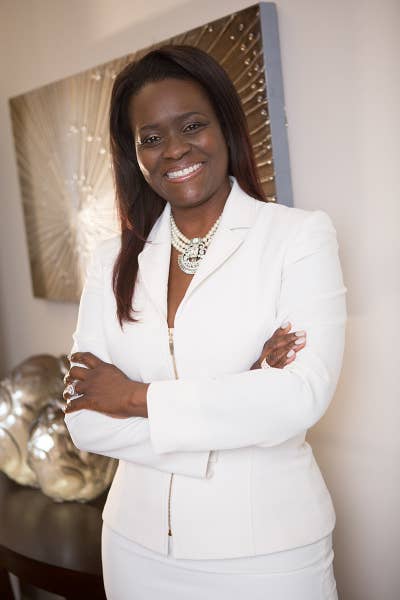
By August, Amazon had awarded her company, VHU Express, an additional 17 locations, stretching from LA to Boston. But as the fall set in, she noticed that once again, Amazon was failing to pay her invoices and she started falling behind on her overhead. Bythewood took out a second line of credit, but it wasn’t enough and drivers started going unpaid.
At least one of those drivers complained to the Department of Labor, which launched an investigation in early 2016. The regulator found that 120 employees were owed a total of nearly $190,000 in back wages and overtime — but determined that nearly all of that should be paid by Amazon rather than VHU, according to Labor Department records.
It was a very unusual finding. Amazon has successfully argued, on multiple occasions in court and to regulators, that it had no responsibility for the treatment of drivers.
The DOL investigator felt differently, noting that because Amazon controlled and supervised the work and working conditions, required VHU to operate out of its facilities, mandated what screenings employees should undergo and what clothing they should wear, and could “dictate who they no longer wanted working as” drivers, it was, in fact, a joint employer.
Amazon acknowledged it had problems with its invoicing system, blaming a variety of factors, including having “moved their accounts payable department to India.” The company vigorously denied being a joint employer, but to get out from under the Labor Department’s thumb, it agreed to pay the workers. It also consented to pay back wages in Florida and Massachusetts, for a total of $352,816.71.
But that didn’t put the matter to rest.
Around the same time, Amazon terminated its contract with Bythewood, who had to lay off about 300 employees. Soon thereafter, it filed a claim against VHU in court, arguing that the firm had violated its contract, which required it to “defend, indemnify, and hold harmless Amazon from any third-party allegation or claim.” Eventually Amazon won a judgment against its former delivery company for nearly $300,000, despite the fact that it had apparently created the entire situation in the first place by failing to pay its invoices. Eventually Bythewood said she settled the dispute with Amazon out of court.
In the meantime, Bythewood, a 51-year old mother of seven, was left facing lawsuits from unpaid lenders, insurers, van leasing companies, and workers. In a bid to help her, Bythewood’s mother emptied her own retirement fund, but it was to no avail: Bythewood and her husband filed for personal bankruptcy a few months later, listing more than $1 million in unpaid Amazon invoices in the filing.
The previous summer, she had been named a finalist in the Tampa Bay Business Journal’s BusinessWoman of the Year awards because her company had landed a contract with Amazon. Now her company was gone.
“You’ve got people chomping at the bit because all they think and see is dollar signs,” said Bythewood, who currently isn’t working. It was hard to say no, she said, because if “you don’t want to do it, someone else will.”
Indeed, Amazon enjoys a glut of entrepreneurs eager for a chance at owning their own chunk of its delivery network. A Facebook group dedicated to people hoping to launch Amazon delivery companies has more than 500 members. They offer each other tips on how to pass the video interview (be sure to use Amazon’s STAR method for answering questions) and thoughts on whether or not $10,000 is actually enough to get started ($30,000 is a safer bet, some say).
“Just got the call I’ve been hoping and praying for, I’m in!” a group member recently posted. “It was a long road, since applying June 2018. God is good.”

Shortly before 3 p.m. on April 19, 2018, a driver for a delivery firm called Last Mile Delivered, Keith Heard, turned left down a four-lane road in a Philadelphia suburb, following delivery directions on his Amazon device. Worried he was about to miss a second left onto a side street, he pulled into an intersection when he heard what he later described as a “thump” and assumed he had somehow hit a pole, according to the police report.
What he had heard, in fact, was the sound of his Ford Transit van slamming into the body of Samuel Cabelus. The 22-year-old Temple University junior had been cruising on a motorcycle down the arterial at the time Heard cut in front of him, and when he tried to stop, his Yamaha hit the pavement and slid toward the van.
Cabelus was crushed under the vehicle, where he died. Heard was cited by police for failing to yield before making a left turn. Cabelus’s grieving parents declined requests for interviews but blame Amazon for the accident, arguing that the company’s policy of pressuring drivers to meet guaranteed delivery times contributed to their son’s death, according to an ongoing lawsuit they filed against Amazon, Last Mile Delivered, and Heard in late 2018.
In court, Amazon vigorously denied liability on the familiar argument that it does not control the delivery firms in its network or employ the drivers. And just as it had again and again — in cases of death, injury, and workplace mistreatment — the company invoked the carefully worded agreement it requires all delivery firms to sign, obliging them to defend and indemnify it from, or assume responsibility for, any and all legal claims. A lawyer representing Last Mile and Heard also denied responsibility for the death in court.
In the year since her son’s death, Cabelus’s mother, Winnie, has written frequent Facebook posts about missing the young man she remembered in one comment as “stubborn, handsome, funny, a great big brother, invincible, charming, and absolutely adored.” In February, she posted an article about the crash in a public Facebook group called Bad Amazon Deliveries. “Please take these unprofessional driver mistakes seriously,” she wrote. “They may cost you life.
“This is about shitty driving, yes,” she added. “But this is about low-paid, inexperienced, and untrained delivery drivers operating gigantic vans they don’t know how to drive, under enormous pressure to deliver quickly. This is profit driven, corporate greed behavior without consideration for anyone else’s humanity.”
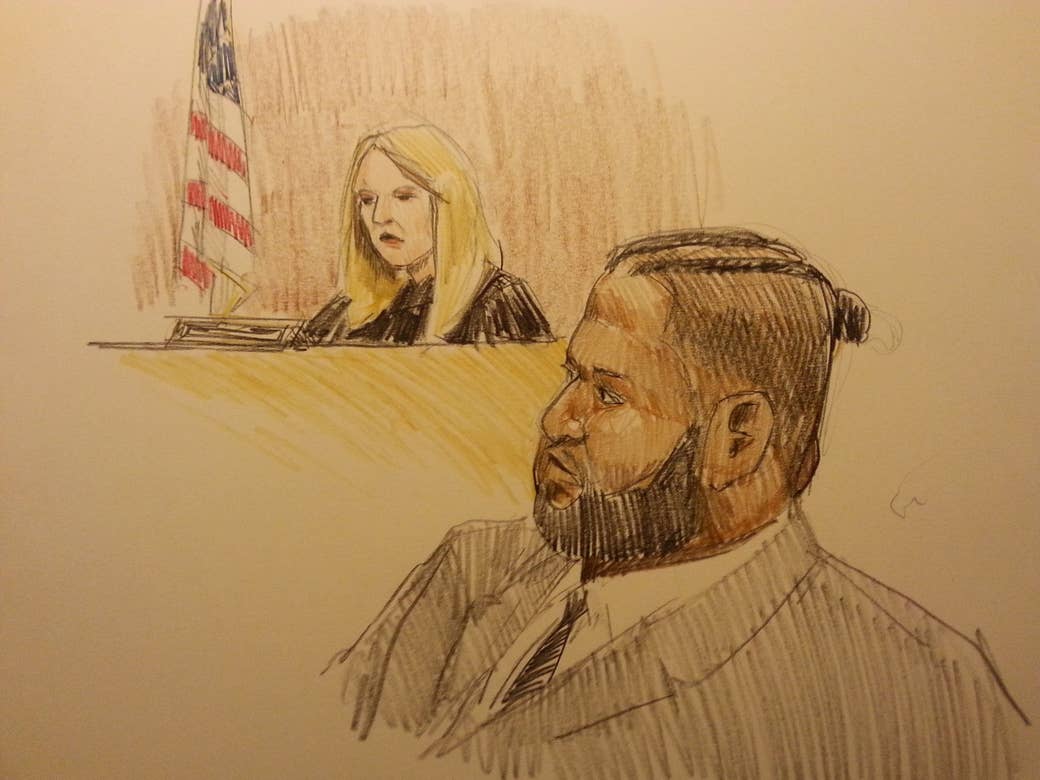
Courtroom sketch of Valdimar Gray during his trial.
Late on the morning of July 31, an attorney for Amazon walked into a dingy, cramped courtroom on the second floor of the Cook County Criminal Courthouse in Chicago. She was there to watch the trial of Valdimar Gray, facing a felony homicide charge in the death of Telesfora Escamilla.
Moments before the trial began, 20 members of the Escamilla family entered the courtroom en masse, taking up half the seats in the gallery. Over two days of testimony, they relived the terrible afternoon of Dec. 22, 2016. On at least a half-dozen occasions, members of the family broke out into tears, sobbing audibly when the circumstances of Telesfora’s death were described.
Gray, who had no previous driving infractions, sat stiffly in a gray blazer and a crisp white shirt. He faced a sentence of between 3 and 14 years in prison if convicted. The Escamillas had pushed hard for him to be prosecuted. The civil suit they had filed against Gray, Inpax, and Amazon couldn’t proceed until Gray’s criminal liability was determined.
Escamilla’s daughter Irma told BuzzFeed News that she had heard about her mother’s death on her way home from work. She had been looking forward to spending Christmas Eve with her mom, a grandmother of 17, who had already purchased tamales for the family’s traditional Christmas Eve dinner.
Instead, she found herself staring at a pool of her mother’s blood on South Drake Avenue. “I still have a hole in my heart for my mom,” said Irma. “She’s not with us. I don’t know if I can overcome this.”
Witnesses testifying for the prosecution described the accident and its aftermath, conceding under cross-examination that Gray might not have been breaking the speed limit, even if he was in a hurry, and had paused, albeit briefly, at a stop sign moments before impact.
Gray’s lawyer, Adam Sheppard, saying the evidence was inconsistent and that Escamilla’s death was a “tragic accident,” called for his client to be acquitted. The judge concurred. Gray’s parents jumped for joy as the Escamilla family sat in shocked disbelief.
But Gray showed little joy.
“I’m not going to celebrate,” he said, walking grimly out of the courtroom with his mother and father.
Letters of support filed in court by friends and family describe how the accident has changed Gray’s once-easygoing personality and how he’s haunted by memories of that afternoon.
On that day, as dusk fell on the corner of West 28th and South Drake, amid crying members of the Escamilla family, gawking rubberneckers, and crowds of local TV news reporters, another Inpax employee quietly arrived on the scene to drive Gray’s Nissan van and the Amazon packages it held back to the Amazon delivery station, just 2 miles away.
Gray was fired the next morning and soon had criminal charges hanging over him. The Escamilla family lost its matriarch. But those boxes and envelopes were absolutely going to get delivered by Christmas.
The urgent memo Amazon sent to Gray’s supervisors at Inpax just five days before the fatal accident described the week as the “home stretch/final sprint” and urged that every driver be made “aware of the expectations for this week.”
“Our #1 priority,” it said, “is getting every package to the customer on time.”
Nowhere did it mention safety. ●
CULTURE
This Viral TikTok From A Deaf Creator Is Moving People To Learn Sign Language
Content Courtesy of: buzzfeednews.com
Written by: Lauren Strapagiel
Chrissy Marshall is inspiring people to pick up American Sign Language.
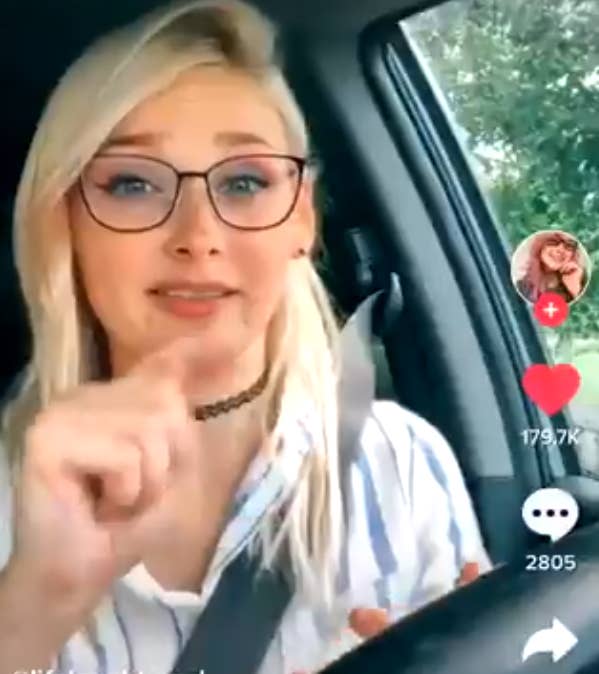
If you don't live with a disability, you may not appreciate how crucial and meaningful community and accessibility are — but one viral TikTok is demonstrating it perfectly.
Chrissy Marshall, a 19-year-old content creator in Los Angeles, was born hard of hearing and became profoundly deaf in high school. Now, she makes content on YouTube and TikTok about her disability and American Sign Language.
One of those videos captures a "special" day she had recently. In the TikTok video, Marshall, looking happy and excited, recounts her day of encountering three people who signed to her in ASL.
"Oh my god. Today has been crazy," she says and signs in the video. "Today I went to three places and all three people signed."
She describes stopping at the bank, where a teller signed with her, then at Starbucks, where a deaf barista signed, and then she grabbed a pretzel, where the worker also signed.
"Everyone signed! It was like a perfect world. It's like a utopia."
The TikTok was reuploaded to Twitter, where it went viral.
"The sun was shining, people were signing, and everything felt so fluid," Marshall told BuzzFeed News in an interview. "I thought I was being pranked or something, like cameras were going to pop out and ask about my day."
"The area has a big deaf community," she added, "and I’m glad and inspired to see the impact it’s had on the greater community as a whole."
The video is making other people happy too, and it's encouraging them to learn ASL.
Marshall said her online platform has given her the opportunity to spread awareness about disability rights, ASL, and deafness.
Her other videos cover what it's like to be deaf. She also posts fun ones like ASL versions of songs.
"I’m so glad it’s just more people I get the opportunity to educate and inspire to be part of the community," said Marshall. "I am a huge advocate for people learning ASL, and I’m happy and grateful so many people were inspired to do so."
A Brief Explainer On Why Everyone's Now Talking About White Claw For People Who're Confused
Written by:Ehis Osifo
If you've been on the internet or have left your apartment in the past few weeks, you might have seen these floating around.
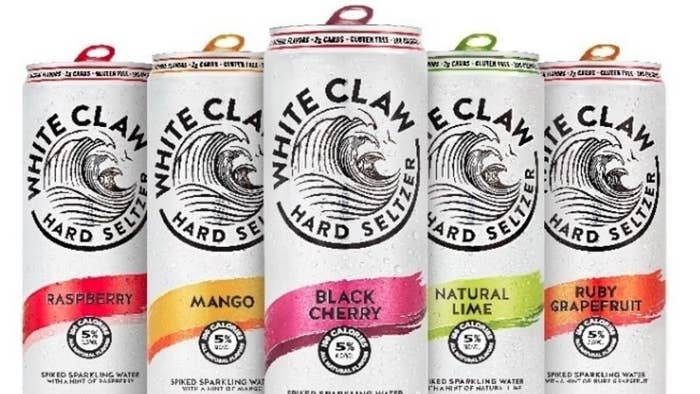
This delicious beverage for our 21+ readers is White Claw. It's a low-cal spiked seltzer that has been on the market since 2016!
You're probs like, "Why is this just NOW becoming a thing?" Or, "I've been drinking claws for YEARS and now all of a sudden it's cool?" To which I say, "Because of Twitter," and "Yes, that's correct."
I would attribute the sudden popularity of White Claw to YouTuber Trevor Wallace, who dropped this parody video a few weeks ago which went viral immediately and put WC on the map.
4 Books We Absolutely Loved Last Month
Written by:

In crafting a coming-of-stage story set under the bleary, borderline-palpable lights of Manhattan’s Times Square in the summer of 1940, author Elizabeth Gilbert has deliberately (but far from ignorantly) eschewed producing a story that mirrors the dark, heavy political and social mire of modern times. Any medium grounded in the year 1940 would, of course, be remiss to ignore the vile storm brewing in the United States (and beyond) at the time, but Gilbert’s dextrous storytelling finds a way of creating a narrative that is somehow politically aware and downright romplike.
And so City of Girls follows the mile-a-minute goings-on of Vivian, a bright-eyed 19-year-old dripping with curiosity who checks off every connotation of the word “virginal” one could possibly procure. Kicked out of Vassar and dropped off in the city, Vivian encounters cheap thrills, a cast of histrionic and outrageous friends, and, of course, the kind of love one can find only in the thick, humid air of New York City. Ultimately, City of Girls provides a sort of summertime escapism that doesn’t sacrifice sharpness or wit, a rare example of a “beach read” with shrewd edge and something to say. What exactly that is really depends on what you’re looking for from Girls, which has something to offer any reader as hungry as its delightfully voracious protagonist. Get your copy now. —Kyle Davis

Bright and motivated, 15-year-old Ilya has achieved what he and his brother Vladmir have dreamed of their whole lives: a ticket to America in the form of an exchange program between his small Russian refinery town, Berlozhniki, and its sister oil town across the world in Louisiana. But Ilya is unable to savor his achievement because his arrival in the States is clouded by Vlad’s recent incarceration back in Russia after confessing to the murders of three women. Convinced of his brother’s innocence, Ilya is determined to set Vlad free with the help of Sadie, the enigmatic eldest daughter of his American host family.
In chapters alternating between Ilya’s life in Russia and his time in the US, Lydia Fitzpatrick’s Lights All Night Long is both a mystery and a coming-of-age story that is plot-driven and engaging without ever skimping on character development or straying from the bond between Ilya and Vlad — the true core of the story. It’s a heartbreaking read, and one I struggled to put down. Fitzpatrick has crafted an impressive debut that feels transportive yet holds within it an intimate study of the ties that bind us to one another — across families, across continents. Get your copy now. —Jillian Karande

Part memoir, part art criticism, part queer theory, part futuristic dream, Trisha Low’s extraordinary book-length essay, Socialist Realism, grapples with questions that have obsessed me lately about modern living: How do we reconcile our desire for love and family with our desire to make the world a better place for everyone else? Is true revolution really possible? And does that even matter?
<The Nickel Boys by Colson Whitehead
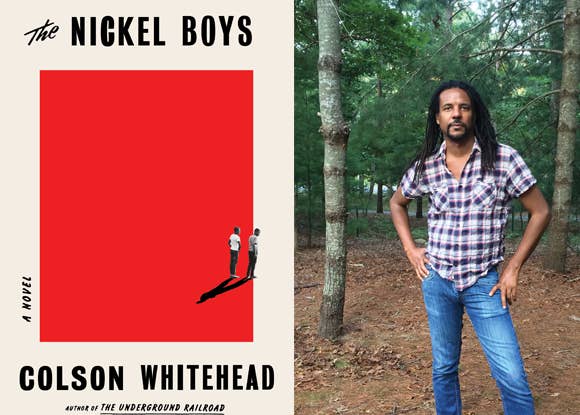
"It was not enough to survive, you have to live."
Colson Whitehead delivers another harrowing tale, filled with rich details about the black experience in America. Inspired by the real-life abuse at the notorious Dozier School for Boys in Florida, Whitehead tells the story of an ambitious young black boy named Elwood Curtis who's sent to the fictional Nickel Academy after being falsely accused of a crime. Elwood quickly learns of the horrific and dehumanizing practices keeping institutionalized racism afloat at Nickel Academy, masked as a reform school for wayward boys. In The Nickel Boys, Whitehead renders the horrors of the Jim Crow era while stirring up feelings of hope. It’s a chilling novel that deserves to be read, despite the pain it conjures up. Get your copy now. —Morgan Murrell
15 Podcasts To Take To The Beach
Written by: Becca James
For when you want to listen to something other than the waves at the beach.
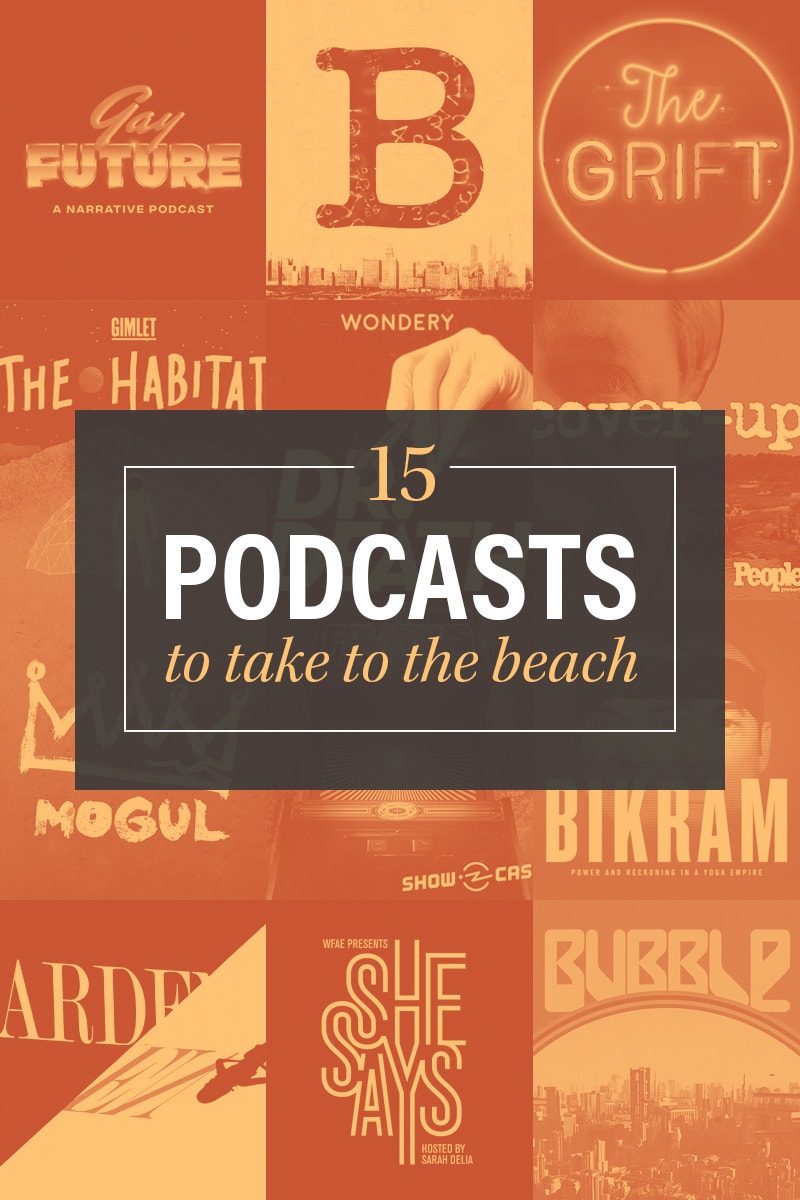
You’ve heard of beach reads, but what about beach listens? Here are some podcasts to dive into before summer ends. In summer the term “beach read” is thrown around with abandon. Everyone—from authors to publications—questions its meaning, unable to reach a consensus. In the same vein, asking what makes a podcast fit for the beach is futile. Instead, we’re recommending 15 outstanding podcasts that range in subject and style, from investigative journalism to narrative fiction, meaning there’s something for everyone… even if you like elaborate video game conspiracy theories. The only catch is that they’re capsules, but that makes them perfect for a weekend at the beach.
1. 16 Shots

16 Shots humanizes the harrowing information surrounding the shooting of Chicago’s Laquan McDonald by police officer Jason Van Dyke. Pushing past crime statistics to offer an in-depth look at “the shooting, the fallout, and the trial,” the podcast provides daily updates and audio clips from the trial itself, leaving the listener in the jury box.
2. BIKRAM
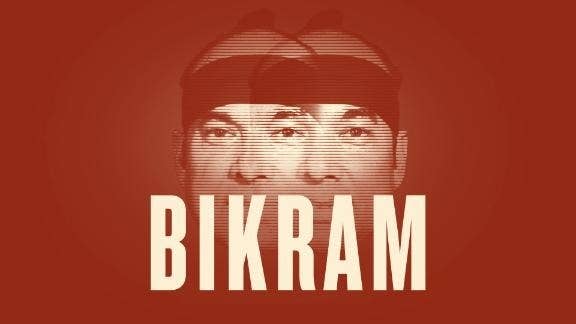
ESPN’s 30 For 30, the popular documentary hub known for producing sports stories “too dramatic not to be real,” brings it in the podcast arena as well. Take BIKRAM, for example, an enthralling five-episode investigation of Bikram Choudhury’s controversial yoga practices from his boom in the ’70s to his current-day bust amid sexual assault allegations.
3. Arden

This fictional mystery-comedy subverts tropes by turning the Dead Girl narrative on its head. Enter missing starlet Julie Capsom who ran her car off the road a decade earlier, leaving behind a male torso in the trunk. Journalist Bea Casely and detective Brenda Bentley are on the case, cracking wise and tracking down bad guys.
4. Articles of Interest
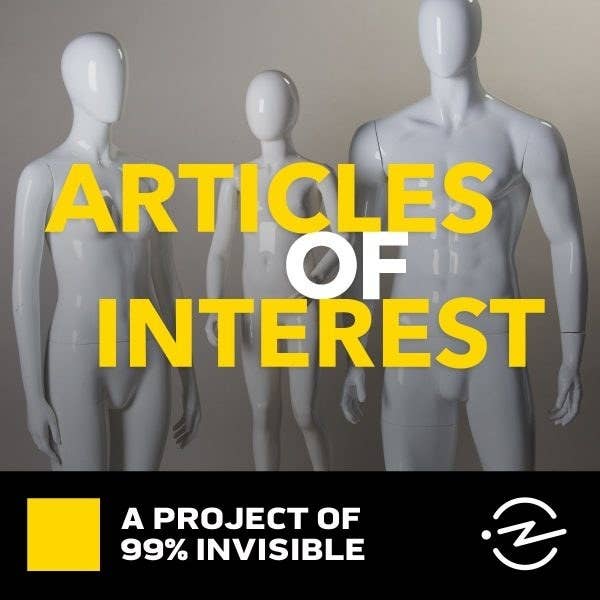
A mini-series from 99% Invisible, Articles of Interest defines itself as a “podcast concept album… on clothes.” Digging deep into design, the podcast tackles tough questions like why womenswear doesn’t have pockets and why kid’s clothes are doused in dangerous chemicals. It also investigates timeless wardrobe staples from Hawaiian shirts to blue jeans with flair.
5. Bronzeville

Directed by and starring Laurence Fishburne and Larenz Tate and scripted by Academy Award-nominated writer Josh Olson, Bronzeville is historical fiction at its finest. Set in the titular Chicago neighborhood once nicknamed the “Black Metropolis,” it chronicles “the lives of players in the lottery games while illuminating the self-sustainability of the community’s African American residents.”
6. Bubble
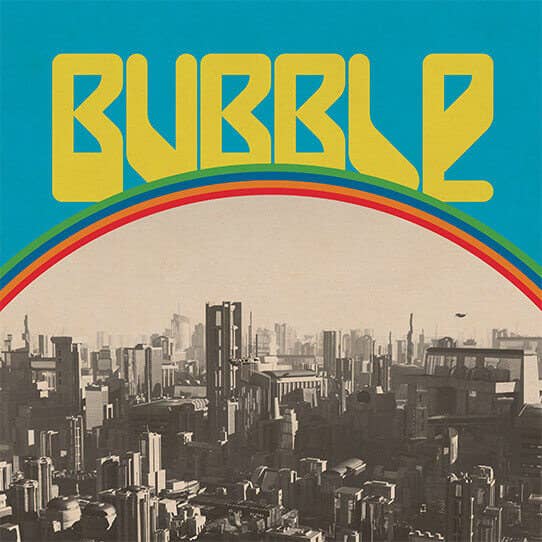
Welcome to fictional Fairhaven—“a literal bubble of corporate utopia.” Bubble goes from satire to sci-fi with the abrupt appearance and killing of a reptilian monster. It’s a cutting and comic look at millennial misadventures that is as addictive as it is absurd, and will have you rooting for a small band of monster hunters.
7. Cover-Up *
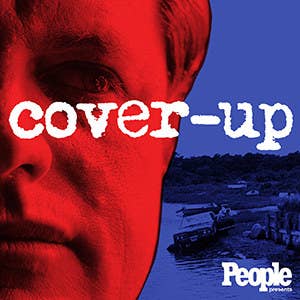
Chappaquiddick has become shorthand for the death of political campaign specialist Mary Jo Kopechne. On People magazine’s first podcast, the publication goes back nearly 50 years to the discovery of her body in Ted Kennedy’s car, which the senator and presidential hopeful had safely escaped from 10 hours before he alerted authorities to the accident.
8. Dr. Death

A clear spiritual sequel to podcast-turned-tv show Dirty John, Dr. Death takes you on a spine-tingling journey as it unfolds the story of neurosurgeon Christopher Duntsch and the profoundly flawed medical system that allowed him to get away with madness. It’s a masterclass in investigative reporting that follows every terrifying turn of malpractice.
9. Gay Future

Purporting to be an “adaptation of a recently discovered, never released YA novel by Mike Pence,” Gay Future is a subversive snack. In a tight six episodes, it brings you to the year 2062 in which (almost) everyone is gay, and the fate of humanity rests on the shoulders of the sole and secret straight.
10. The Grift

It’s always scammer season. The Grift, “a show about con artists and the lives they ruin,” investigates all sorts of swindlers—from card sharks to cult leaders—while trying to find out why we keep falling for it. It’s an intriguing look at the history of con artists filled with tips—er, tricks—of the trade.
11. The Habitat

The Habitat is a “true story of a fake planet.” Following six volunteers in an “imitation Mars habitat where they will work as imitation astronauts for one very real year,” it’s secluded setting, and mission-oriented focus is reminiscent of Survivor, and it’s just as addictive. Tune in in preparation for the day we blast off.
12. Mogul

Documenting the life and eventual suicide of Chris Lighty, the wildly successful hip-hop honcho, Mogul acts as a biography for both the man and the music. It shines a stark light on the price of pursuing the American dream while working to humanize Lightly as much as it honors him and his contributions to the genre.
13. The Polybius Conspiracy

This is an epic and elaborate video game conspiracy theory. Polybius, the mysterious ’80s arcade game “whose alleged existence in the Pacific Northwest is fueled by myth and an obsessive online fan base, and which may have factored in the abduction of two teenage boys” anchors this deep-dive into the enduring power of urban legends.
14. Seeing White

Scene On Radio is doing some of the best cultural explorations out there, and Seeing White is no exception. Posing the pertinent question, “just what is going on with white people?” it aims to “[explore] whiteness in America—where it came from, what it means, and how it works” by centering and supporting people of color.
15. She Says
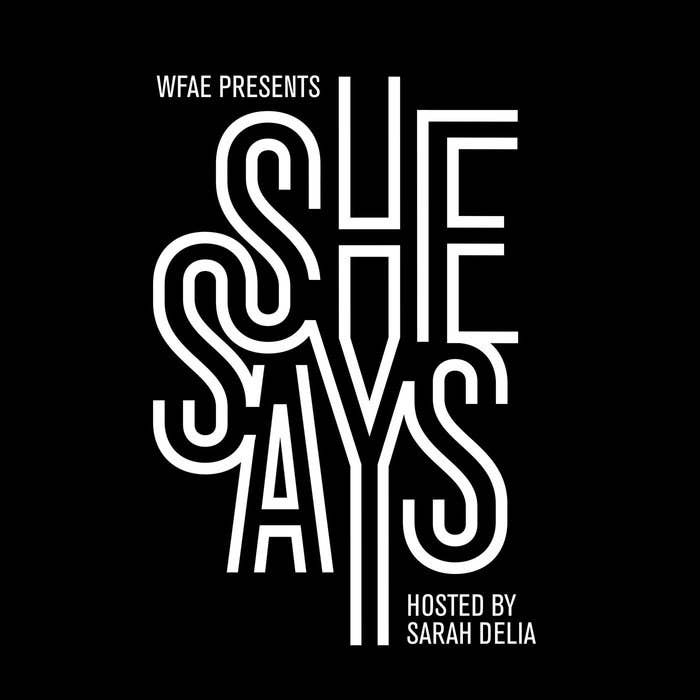
Through interviews with detectives, forensic scientists, and survivors, She Says offers an in-depth look at the criminal justice system’s approach to sexual assault cases. Focusing on “a Charlotte-area woman who was sexually assaulted by a stranger in 2015… and is still struggling to find answers” years later, the podcast traces the long and winding road of resolution.
ADVERTISING
15 Minutes to ‘Mayhem’: How a Tweet Led to a Shortage at Popeyes
The “chicken sandwich wars” with Chick-fil-A captivated the internet and drove record sales. Then they became a logistical headache.

Content Courtesy of: nytimes.com
Written by: David Yaffe-Bellany and Matthew Sedacca
They started a war in 15 minutes.
At 1:43 p.m. on Aug. 19, Bruno Cardinali, a marketing executive for Popeyes Louisiana Kitchen, got a WhatsApp message from a colleague: That morning, one of Popeyes’ fast-food rivals, Chick-fil-A, had tweeted what appeared to be a thinly veiled critique of the new fried chicken sandwich that Popeyes had started offering nationwide a few days earlier.
Mr. Cardinali quickly convened a group of marketing officials in a small room on the fifth floor of the Popeyes headquarters in Miami. A high-speed brainstorming session ensued, and before long, the team settled on what seemed like the perfect response: “... y’all good?”
The tweet appeared on the official Popeyes account at 1:58 p.m.
“It was 15 minutes of turnaround putting out the tweet that triggered the whole thing,” Mr. Cardinali said. “And at that moment, we braced ourselves.”
What the tweet set off were the “chicken sandwich wars,” a viral social media debate that has captivated the internet for the last week and a half. Popeyes, Chick-fil-A and other fast-food brands traded barbs on Twitter, arguing about whose sandwich tasted best. As sandwich memes proliferated, customers flocked to Popeyes restaurants across the country, forcing employees to work hours of overtime as location after location sold out of the sandwiches.
As the chain’s sandwich supply rapidly dwindled, top Popeyes executives working behind the scenes in Miami were ebullient: A two-word tweet had turned the chicken sandwich rollout into the most successful product launch in the company’s history. But the success of the sandwich was also creating a logistical headache.
In a tweet on Tuesday, Popeyes announced that its chicken sandwich inventory was exhausted: For the time being, the chain said, its stores would have to stop offering the sandwich, which sold for $3.99. (Popeyes declined to reveal how many sandwiches it had sold over the last week and a half.)
“We had very aggressively forecasted the demand, and we thought we wouldn’t have any problems at all, at least until the end of September,” said Felipe Athayde, the Popeyes president for the United States market. “And then two weeks go by, and we’re out of the product on a national level.”
All of last week, Mr. Athayde had fielded calls and emails about the shortages. But it wasn’t until that Friday evening that he made a decision. The chain’s senior leadership had gathered in a fifth-floor meeting room. Some officials were on laptops, while others examined printed spreadsheets showing sandwich sales across the country.
“Guys, look,” Mr. Athayde said to the group. “I think we’re going to have to hit the brakes.”
In the end, the decision came down to simple mathematics, Mr. Athayde said in an interview this week. With 2,400 locations, Popeyes is one of the largest fried chicken chains in the United States. But it did not have enough chicken to keep making the sandwiches.












